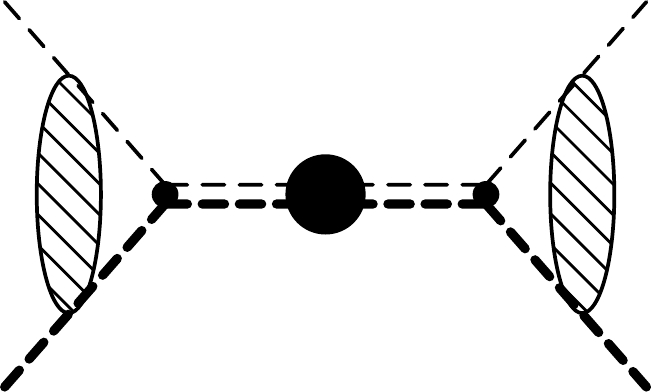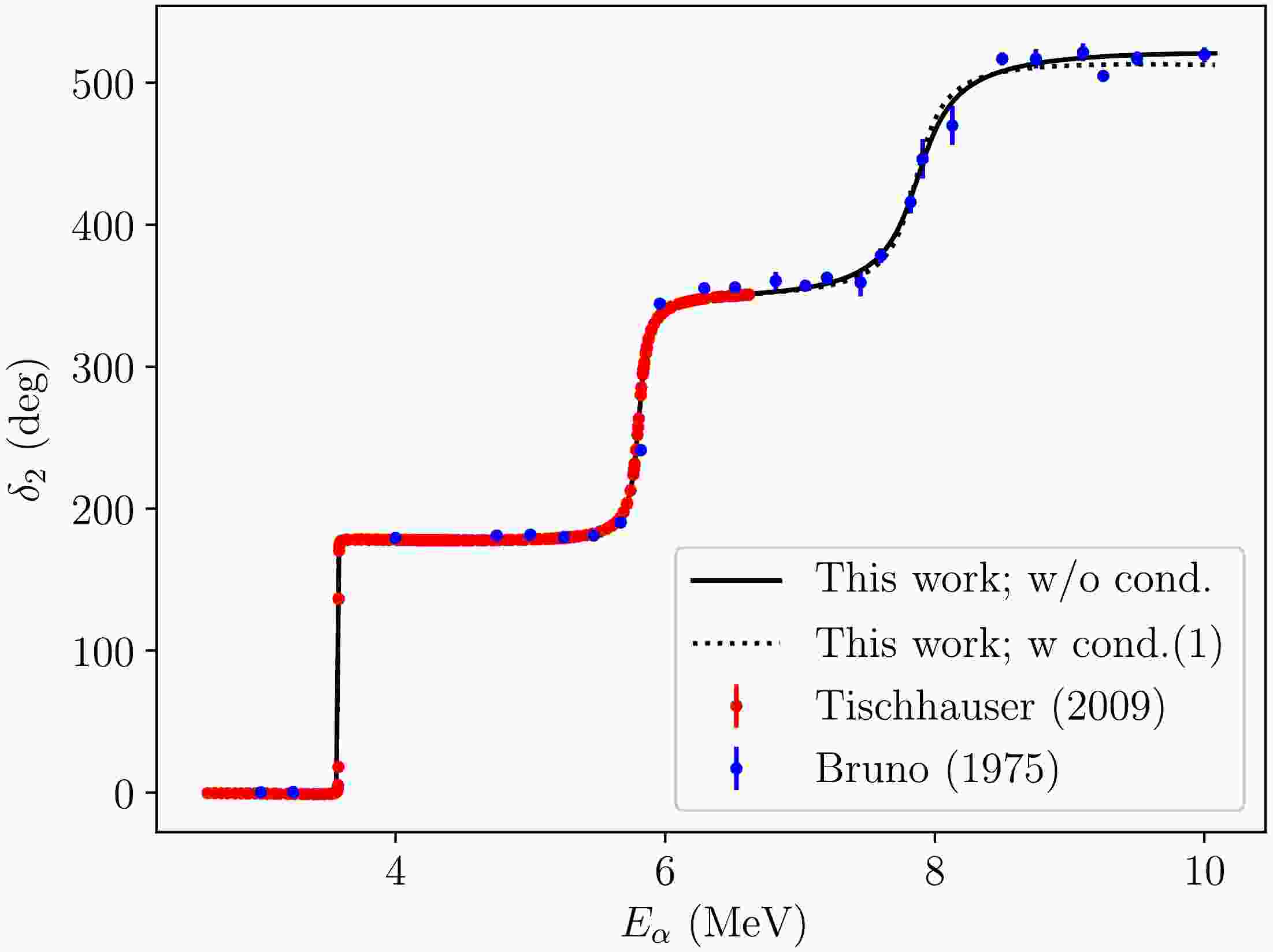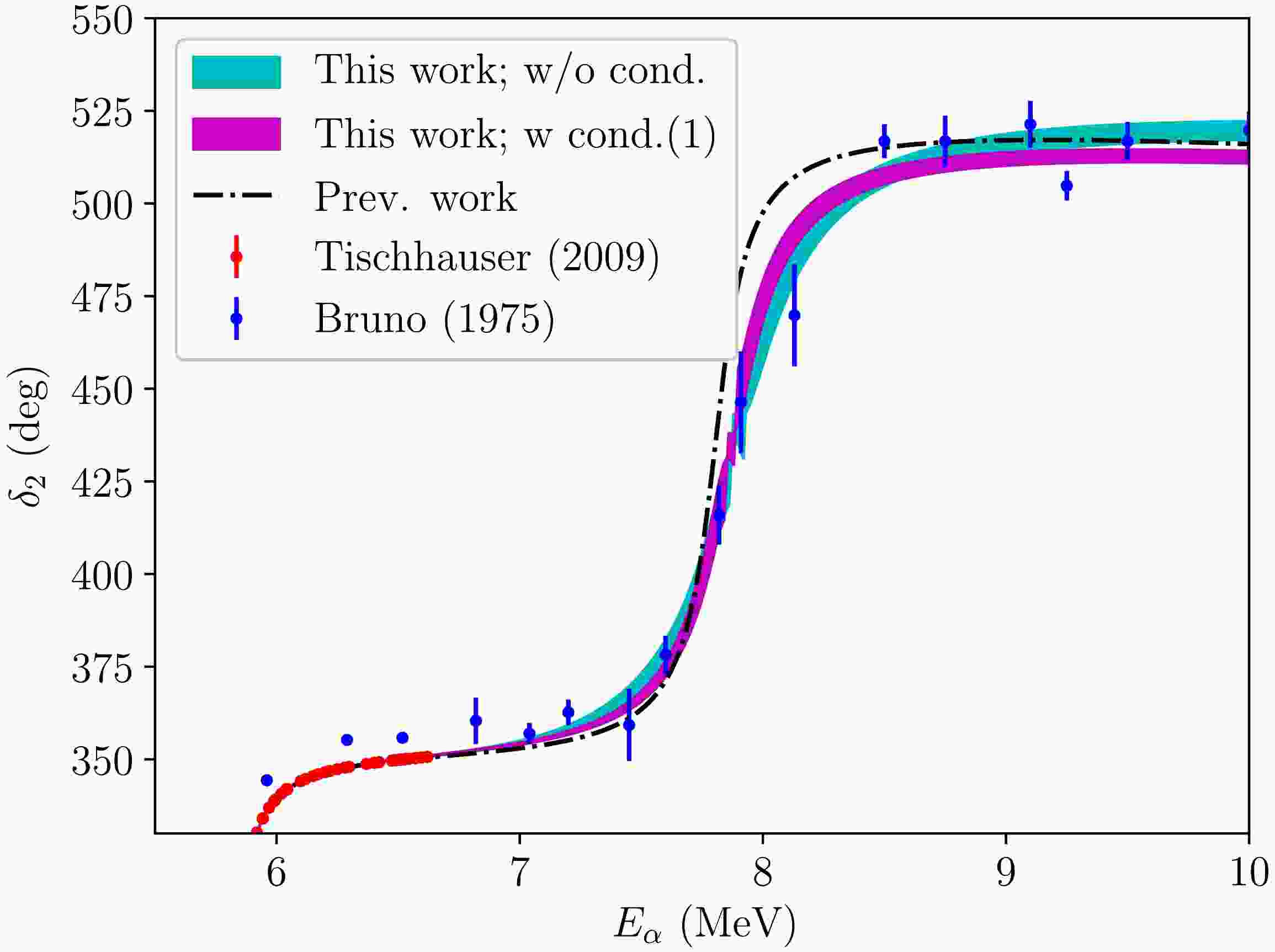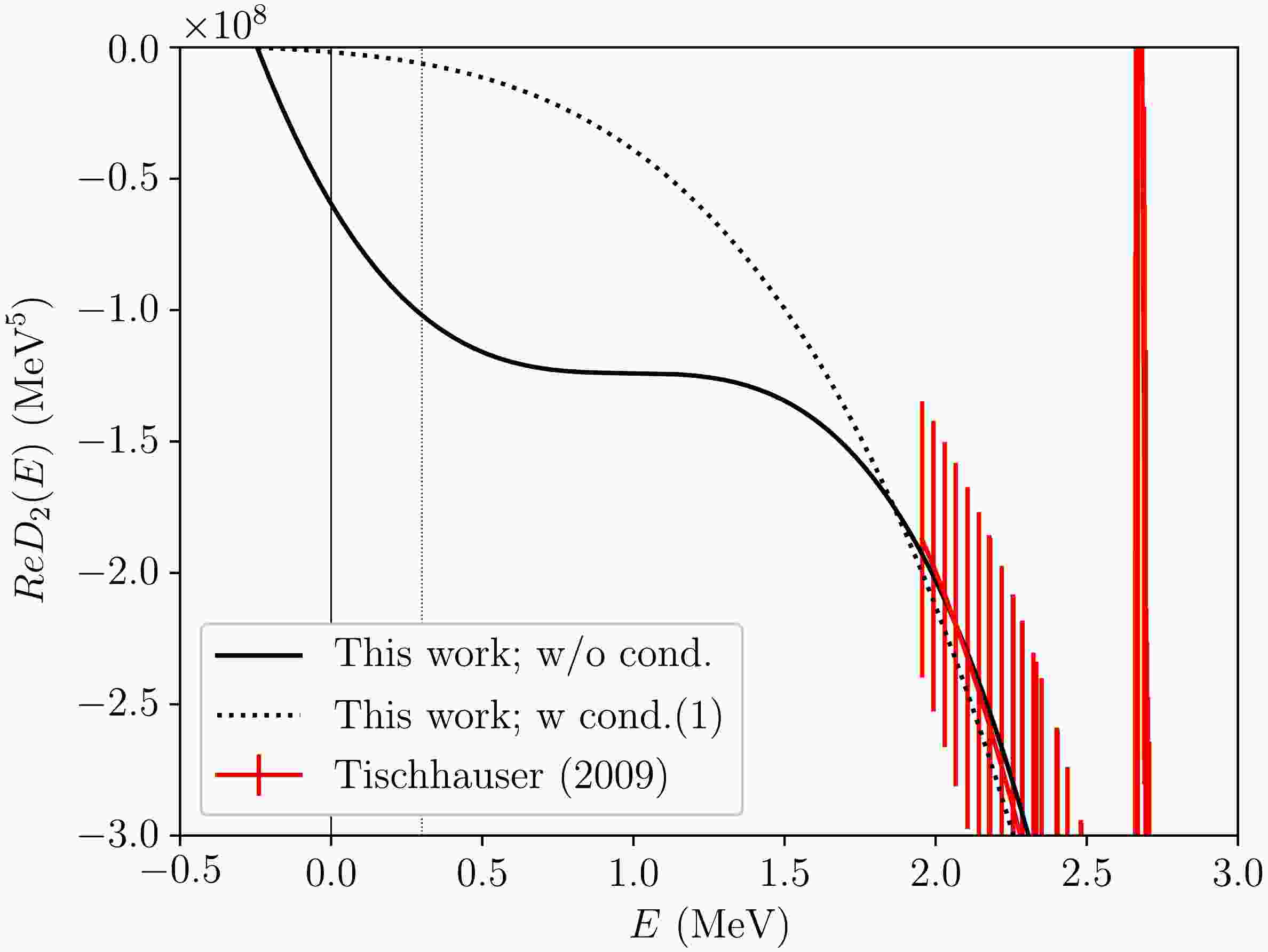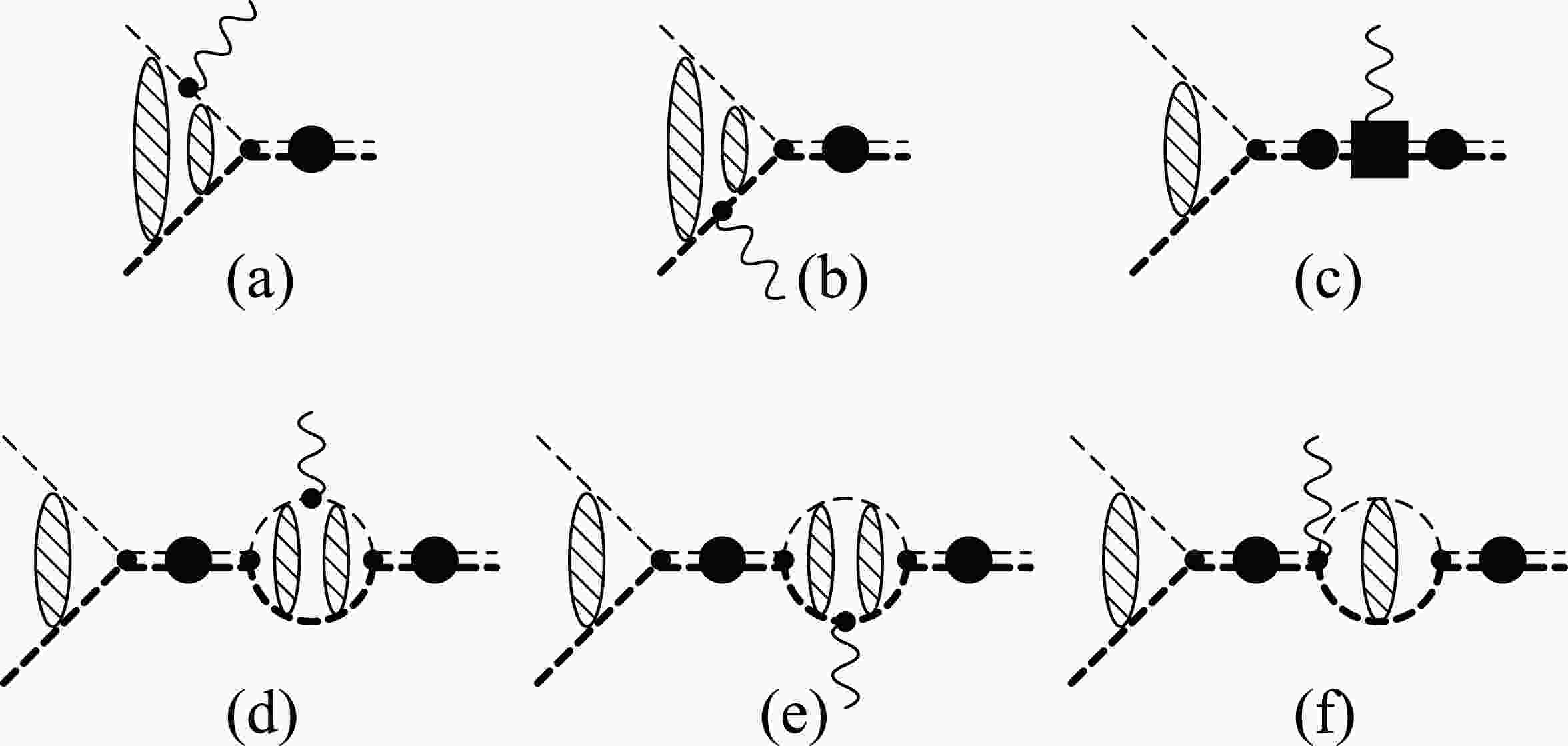-
The radiative α capture on 12C, 12C(α,γ)16O, is one of the fundamental reactions in nuclear astrophysics, which determines, along with the triple α reaction, the C/O ratio in the core of a helium-burning star [1]. It provides an initial condition for computer simulations of star evolution [2, 3] and leads to a significant influence on the results of star explosions and nucleosynthesis [4]. The reaction rate, or equivalently the astrophysical S factor of 12C(α,γ)16O at the Gamow-peak energy,
$ E_G=0.3 $ MeV, however, has not been measured in an experimental facility because of the Coulomb barrier. One needs to employ a theoretical model, fit the model parameters to experimental data measured at a few MeV energy, and extrapolate the reaction rate to$ E_G $ . While it is known that E1 and E2 transitions of 12C(α,γ)16O are dominant due to the subthreshold$ 1_1^- $ and$ 2_1^+ $ ($ l^\pi_{ith} $ ) states of 16O, whose binding energies respected to the α-12C breakup energy are$ B_1=0.045 $ MeV and$ B_2=0.245 $ MeV, respectively [5]. During the last half-century, many experimental and theoretical studies on the reaction have been carried out. For a review, refer, e.g., to Refs. [6−10]. (For a brief review, see Ref. [11].)We have been studying reactions related to 12C(α,γ)16O by constructing a low-energy effective field theory (EFT) based on the methodology of quantum field theory [12−14]. When constructing an EFT, one first chooses a typical scale of a reaction to study and then introduces a large scale by which relevant degrees of freedom at low energy are separated from irrelevant degrees of freedom from high energy. We choose the Gamow-peak energy,
$ E_G=0.3 $ MeV, as a typical energy scale; a typical momentum scale would be$ Q=\sqrt{2\mu E_G}=40 $ MeV where μ is the reduced mass of α and 12C.1 Because the typical wavelength of the reaction is larger than the size of the nuclei, nucleons inside the nuclei would be irrelevant; we assign α and 12C as structure-less (point-like) spin-0 scalar fields. We then choose the energy difference between p-15N and α-12C breakup energies of 16O;$ \Delta E = 12.13 - 7.16 = 4.97 $ MeV, as the high energy (separation) scale; the high momentum scale is$ \Lambda_H = \sqrt{2\mu \Delta E} = 160 $ MeV. The theory provides us with a perturbative expansion scheme and the expansion parameter would be$ Q/\Lambda_H = 1/4 $ . The p-15N system is now regarded as irrelevant degrees of freedom and integrated out of the effective Lagrangian, whose effects are embedded in the coefficients of terms of the Lagrangian. Those coefficients can, in principle, be determined from the mother theory, while they, in practice, are fixed by using experimental data or empirical values of them. Because of the perturbative expansion scheme of EFT, by truncating the terms up to a given order, one can have an expression of reaction amplitudes in terms of a few parameters for each of the reaction channels. This approach was recently used for the study of reactions, which are important in nuclear astrophysics, such as elastic p-12C scattering [15], elastic d-α scattering [16], and radiative proton capture on 15N [17, 18].In the previous works, we studied various cases of elastic α-12C scattering at low energies [19−23], E1 transition of 12C(α,γ)16O and an estimate of
$ S_{E1} $ factor of 12C(α,γ)16O at$ E_G $ [24], and β delayed α emission from 16N [10] up to the sub-leading order within the cluster EFT. The experimental data of each of the reactions are well reproduced by the fitted values of the parameters of reaction amplitudes, but a problem we observed in the previous work (see Fig. 6 in Ref. [22]) is that, by using the fitted parameters to the precise phase shift data up to the p-15N breakup energy,$ E_\alpha = 6.62 $ MeV ($ E_\alpha $ is the α energy in the laboratory frame), reported by Tischhauser et al. (2009) [25], a path of the inverse of dressed 16O propagator for$ l=2 $ cannot be uniquely determined in the low-energy region, where the$ S_{E2} $ factor is extrapolated to$ E_G $ . In this work, we study this issue, by introducing conditions applied to the effective range parameters in the low-energy region, employing two kinds of experimental data, the phase shift of the elastic α-12C scattering explicitly including resonant$ 2_4^+ $ state of 16O and the$ S_{E2} $ factor of 12C(α,γ)16O below the energy of sharp resonant$ 2_2^+ $ state of 16O.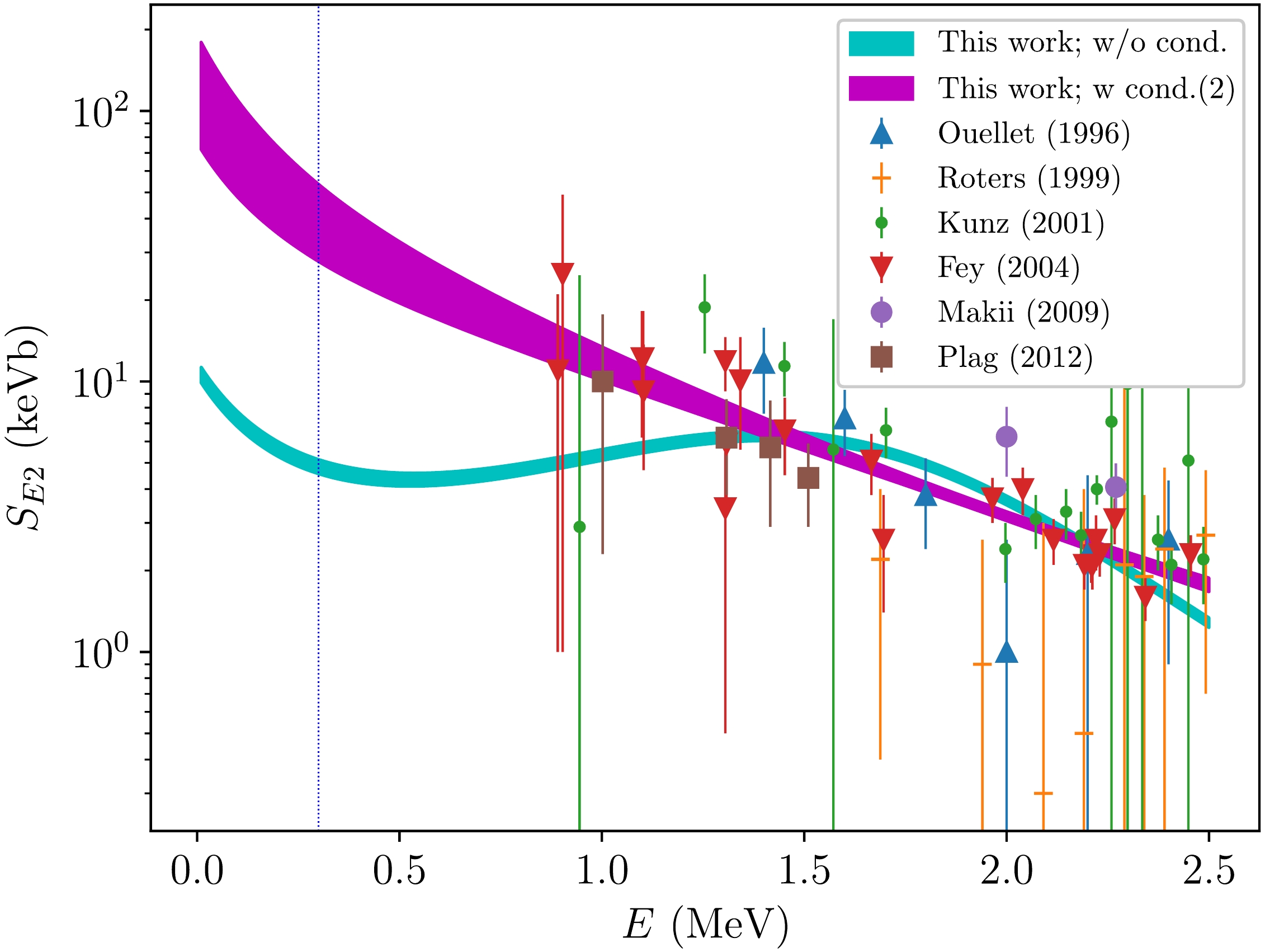
Figure 6. (color online)
$ S_{E2} $ factor of 12C(α,γ)16O plotted as functions of the energy E of the initial α-12C state in the center-of-mass frame. The two bands are plotted by using the fitted parameters presented in Table 3. The bands, the 16% to 84% distribution of the$ S_{E2} $ factor, are calculated from the samples of the parameters,$ h_2^{(R)} $ and$ y^{(0)} $ , in the MCMC analysis. The experimental data (see the text) are included in the figure as well. The vertical blue line is drawn at$ E_G=0.3 $ MeV.A known problem in the study of the elastic α-12C scattering for
$ l=2 $ at low energy is that the asymptotic normalization coefficient (ANC) of the subthreshold$ 2_1^+ $ state of 16O calculated from the effective range parameters is significantly smaller than the values deduced from other reactions, such as the α transfer reactions. An estimate of the ANC of the subthreshold$ 2_1^+ $ state of 16O,$ |C_b|_2 $ , using the effective range parameters was reported by König, Lee, and Hammer as$ |C_b|_2 = (2.41\pm 0.38)\times 10^4 $ fm−1/2 [26], which is about a factor of five smaller than the value of$ |C_b|_2 = (1.11\pm 0.11)\times 10^5 $ fm−1/2 deduced from the α-transfer reactions, 12C(6Li,d)16O and 12C(7Li,t)16O [27]. While a large uncertainty of the ANC of the$ 2_1^+ $ state deduced from the elastic α-12C scattering within a potential model, with values ranging from 2 to$ 18\times 10^4 $ fm−1/2, was reported by Sparenberg, Capel, and Baye [28]. (The values of ANC of the$ 2_1^+ $ state of 16O in the literature are summarized, e.g., in Table 2 in Ref. [29].) As will be discussed in the following, the inverse of the dressed 16O propagator for$ l=2 $ is represented in terms of the three effective range parameters,$ r_2 $ ,$ P_2 $ ,$ Q_2 $ , which approximately configure a cubic polynomial function. In Fig. 6 in Ref. [22], three kinds of lines, 1) having a maximum point and a minimum point, 2) having a plateau, and 3) simply decreasing one, were obtained from the cubic function in the low energy region, where there are no data points to determine which line is correct, even though those sets of fitted values of the effective range parameters evenly reproduce the accurate phase shift data well. Thus, we introduce the conditions to the effective range parameters, which make a value of the ANC of the$ 2_1^+ $ state larger and the line of the inverse of the dressed 16O propagator for$ l=2 $ simply decreasing. Because there is no verification of the conditions, we discuss its reliability by studying the effects of the conditions on the observable of the resonant$ 2_4^+ $ state of 16O and the estimate of the$ S_{E2} $ factor of 12C(α,γ)16O at$ E_G $ .Bruno (1975) TWC (1993) deBoer (2012) This work w/o cond. This work w cond.(1) $ E_{R(24)} $ (MeV)

5.83(3) 5.858(10) 5.805(2) 5.92(2) 5.90(2) $ \Gamma_{R(24)} $ (keV)

520(200) 150(10) 349(3) $300 ^{+60}_{-40} $ 

235(20) Table 2. Resonant energy and width of the
$ 2_4^+ $ state of 16O. The values in the second, third, and fourth columns are from the literature; Bruno et al. (1975) [30], the compilation edited by Tilley, Weller, and Cheves (TWC) (1993) [5], and deBoer et al. (2012) [36], respectively. Those in the fifth and sixth columns are the fitted values of this work without and with the conditions applied to the effective range parameters.In this work, we first study the elastic α-12C scattering at low energies including the resonant
$ 2_4^+ $ state of 16O in the cluster EFT. A set of the experimental data of the phase shift up to$ E_\alpha = 10 $ MeV, reported by Bruno et al. (1975) [30] is employed along with the precise phase shift data reported by Tischhauser et al. (2009) [25]. The resonant$ 2_4^+ $ state of 16O appears at$ E_\alpha = \frac43 E_{R(24)} = 7.9 $ MeV, where$ E_{R(24)} $ is the resonant energy of the$ 2_4^+ $ state of 16O,$ E_{R(24)}=5.86 $ MeV [5]. We introduce the conditions to restrict the parameter space of the effective range parameters in the low-energy region,$ E_\alpha = 0 $ – 2.6 MeV, and parameters of the S matrix of the elastic α-12C scattering for$ l=2 $ are fitted to the two sets of the phase shift data for three cases; one is without applying the conditions to the effective range parameters and the other two are those applied the conditions in the parameter fit. For one of the two, we employ a value of the ANC of the$ 2_1^+ $ state of 16O to fix a value of one of the effective range parameters. For all cases, the fitted parameters reproduce the phase shift data well, but we find a large difference in the values of the ANC of the$ 2_1^+ $ state of 16O; we confirm that the ANC of the$ 2_1^+ $ state of 16O cannot be determined by the phase shift data of the elastic α-12C scattering for$ l=2 $ . We also find the noticeable differences in the values of parameters for the resonant$ 2_4^+ $ state of 16O. We compare the fitted values of the resonant energy and width of the$ 2_4^+ $ state of 16O with those in the literature.We then employ the experimental data of the
$ S_{E2} $ factor of 12C(α,γ)16O. First, we study the energy dependence of the inverse of the dressed 16O propagator for$ l=2 $ in the low-energy region. We fix one of the effective range parameters for the large value of the ANC to reproduce a value of the ANC of the$ 2_1^+ $ state of 16O deduced from the α-transfer reactions. Then, using the fitted values of the effective range parameters for two of the three cases, two additional parameters,$ y^{(0)} $ and$ h_R^{(2)} $ , of E2 transition amplitudes of 12C(α,γ)16O are fitted to the experimental data of the$ S_{E2} $ factor. We find the$ \chi^2 $ values as$ \chi^2/N = 1.18 $ and 1.55, for the cases with and without applying the conditions, respectively, where N is the number of the data of the$ S_{E2} $ factor. Then, the$ S_{E2} $ factor is extrapolated to$ E_G=0.3 $ MeV; we find quite different values of the$ S_{E2} $ factor at$ E_G $ . We discuss the significance of introducing the conditions in the observables of the$ 2_4^+ $ state of 16O and the estimate of the$ S_{E2} $ factor at$ E_G $ and argue the necessity to adopt a value of the ANC of the$ 2_1^+ $ state of 16O deduced from the α-transfer reactions to reduce the uncertainty in fixing the effective range parameters of the$ 2_1^+ $ state of 16O.2 This paper is organized as follows. In Section 2, we review the expression of the S matrix of the elastic α-12C scattering for
$ l=2 $ in the cluster EFT. In Section 3, the numerical results of this work are presented; in Section 3.1, the conditions applied to the effective range parameters are discussed, and in Section 3.2, the parameters of the S matrix for$ l=2 $ are fitted to the experimental phase shift data, and the fitted values of the resonant energy and width of the$ 2_4^+ $ state of 16O are compared with those in the literature. In Section 3.3, the energy dependence of the inverse of the dressed 16O propagator for$ l=2 $ on the conditions in the low energy region is studied. Then, two additional parameters of the E2 transition amplitudes of 12C(α,γ)16O are fitted to the experimental data of$ S_{E2} $ factor and the$ S_{E2} $ factor is extrapolated to$ E_G $ . The numerical results of the$ S_{E2} $ factor are presented and discussed. Finally, in Section 4, the results and discussion of this work are presented. In Appendix A, the expansion formulas of the digamma function and the inverse of the dressed 16O propagator for$ l=2 $ are summarized, and in Appendix B, the expression and derivation of the E2 transition amplitudes of 12C(α,γ)16O in the cluster EFT are briefly discussed. -
In this section, we review the expression of the S matrices of the elastic α-12C scattering at low energies and its brief derivation in the cluster EFT [23]. The S matrices of the elastic α-12C scattering for lth partial wave states are given in terms of phase shifts,
$ \delta_l $ , and elastic scattering amplitudes,$ \tilde{A}_l $ , as$ \begin{aligned} S_l = e^{2i\delta_l} = 1 + 2ip\tilde{A}_l\,. \end{aligned} $

(1) We now assume that the phase shifts can be decomposed as
$ \begin{aligned} \delta_l = \delta_l^{(bs)} + \delta_l^{(rs1)} + \delta_l^{(rs2)} + \delta_l^{(rs3)} \,, \end{aligned} $

(2) where
$ \delta_l^{(bs)} $ is a phase shift generated from a bound state, and$ \delta_l^{(rsN)} $ with$ N=1,2,3 $ are those from the first, second, and third resonant states, and each of those phase shifts may have a relation to a corresponding scattering amplitude as$ \begin{aligned} e^{2i\delta_l^{(ch)}} &= 1 + 2ip\tilde{A}_l^{(ch)}\,, \end{aligned} $

(3) where
$ ch(annel) = bs, rsN $ , and$ \tilde{A}_l^{(bs)} $ and$ \tilde{A}_l^{(rsN)} $ with$ N=1,2,3 $ are the amplitudes for the binding part and the first, second, and third resonant parts of the amplitudes, which are derived from the effective Lagrangian in Ref. [23]. The total amplitudes$ \tilde{A}_l $ for the nuclear reaction part in terms of the four amplitudes,$ \tilde{A}_l^{(bs)} $ and$ \tilde{A}_l^{(rsN)} $ with$ N=1,2,3 $ , read$ \begin{aligned}[b] \tilde{A}_l =\;& \tilde{A}_l^{(bs)} + e^{2i\delta_l^{(bs)}} \tilde{A}_l^{(rs1)} + e^{2i(\delta_l^{(bs)}+\delta_l^{(rs1)})} \tilde{A}_l^{(rs2)} \\&+ e^{2i(\delta_l^{(bs)}+\delta_l^{(rs1)}+\delta_l^{(rs2)})} \tilde{A}_l^{(rs3)} \,. \end{aligned} $

(4) We note that the total amplitudes are not obtained as the summation of the amplitudes, but the additional phase factors appear in front of them.
The amplitudes are calculated by using the diagrams in Figs. 1 and 2 [19, 20, 22]. In the present study of the elastic α-12C scattering for
$ l=2 $ , we include the subthreshold bound$ 2_1^+ $ state and three resonant$ 2_2^+ $ ,$ 2_3^+ $ ,$ 2_4^+ $ states of 16O. For the bound state amplitude,$ \tilde{A}_l^{(bs)} $ with$ l=2 $ , one has
Figure 1. Diagrams for dressed 16O propagators. A thick and thin double dashed line with or without a filled circle represents the dressed or bare 16O propagator, respectively. A thick (thin) dashed line represents a propagator of 12C (α), and a shaded blob in the loop diagrams represents the Coulomb Green's function.
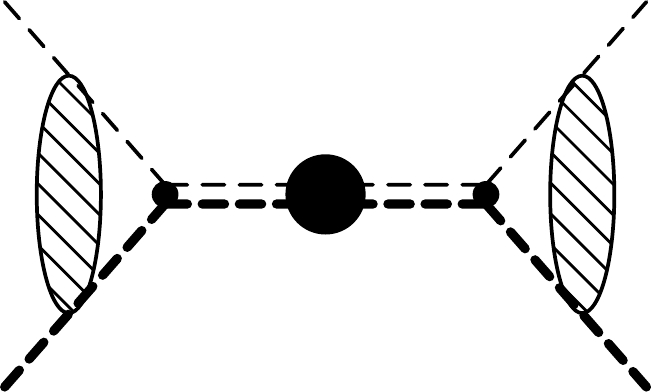
Figure 2. Diagram for elastic α-12C scattering amplitudes. A shaded blob represents the initial or final Coulomb wave function, and a thick and thin double-dashed line with a filled circle a dressed 16O propagator. See the caption of Fig. 1 as well.
$ \begin{aligned} \tilde{A}^{(bs)}_2 &= \frac{C_\eta^2 W_2(p)}{ K_2(p) -2\kappa H_2(p) } \,, \end{aligned} $

(5) where
$ C_\eta^2 W_2(p) $ in the numerator of the amplitude is calculated from the initial and final state Coulomb interactions for$ l=2 $ in Fig. 2; p is the magnitude of relative momentum of the α-12C system in the center of mass frame,$ p=\sqrt{2\mu E} $ , where E is the energy of the α-12C system, and$ \begin{aligned} W_2(p) = \frac14 \left(\kappa^2 + 4 p^2\right) \left(\kappa^2 + p^2\right) \,, \ \ C_\eta^2 = \frac{2\pi\eta}{\exp(2\pi\eta)-1}\,, \end{aligned} $

(6) where η is the Sommerfeld parameter,
$ \eta=\kappa/p $ : κ is the inverse of the Bohr radius,$ \kappa = Z_\alpha Z_{12C} \alpha_E\mu $ , where$ Z_A $ is the number of protons in a nucleus, and$ \alpha_E $ is the fine structure constant. One has$ \kappa=245 $ MeV, which is regarded as a large scale of the theory because of$ \kappa > \Lambda_H $ . The function$ -2\kappa H_2(p) $ in the denominator of the amplitude is the Coulomb self-energy term, which is calculated from the loop diagram in Fig. 1, and one has$ \begin{aligned} H_2(p) = W_2(p) H(\eta)\, , \ \ \ H(\eta) = \psi(i\eta) + \frac{1}{2i\eta} -\ln(i\eta)\,, \end{aligned} $

(7) where
$ \psi(z) $ is the digamma function. As discussed in Ref. [20], large and significant contributions to the series of effective range expansions, compared to the terms calculated using a phase shift datum at the lowest energy of the data,$ E_\alpha=2.6 $ MeV [25], appear from the Coulomb self-energy term,$ -2\kappa H_l(p) $ with$ l=0,1,2 $ . In addition, for$ l=2 $ , one can find the appearance of the large terms by expanding the self-energy term,$ 2\kappa H_2(p) $ , in terms of$ 1/\eta^2=(p/\kappa)^2 $ in$ p\to 0 $ limit. Expressions of the function$ H_2(p) $ expanded in powers of$ (p/\kappa)^2 $ are presented in Appendix A. Thus, one has$ \begin{aligned}[b] 2\kappa ReH_2(p) =\;& \frac{1}{24}\kappa^3 p^2 + \frac{17}{80}\kappa p^4 + \frac{757}{4032\kappa}p^6 \\&+ \frac{289}{10080\kappa^3}p^8 + \frac{491}{22176\kappa^5}p^{10} + \cdots\,, \end{aligned} $

(8) where one may notice that the large terms proportional to
$ \kappa^3 $ and κ appear in the first and second terms on the right-hand side of the equation. Those terms are regarded as the terms that do not obey the counting rules and need to be subtracted by the counter terms [32, 33].Nuclear interaction is represented in terms of the effective range parameters in the function
$ K_2(p) $ in the denominator of the amplitude in Eq. (5). We introduce two terms proportional to$ p^2 $ and$ p^4 $ as leading order contributions, to subtract the two large contributions from the self-energy term mentioned above, and a term proportional to$ p^6 $ as a sub-leading one; the effective range terms up to$ p^6 $ order are included for$ l=2 $ , and we have$ \begin{aligned} K_2(p) =-\frac{1}{a_2} +\frac12 r_2p^2 -\frac14 P_2 p^4 +Q_2 p^6 \,, \end{aligned} $

(9) where
$ a_2 $ ,$ r_2 $ ,$ P_2 $ ,$ Q_2 $ are the effective range parameters for$ l=2 $ .We fix a parameter among the four effective range parameters,
$ a_2 $ ,$ r_2 $ ,$ P_2 $ ,$ Q_2 $ , by using a condition that the inverse of the scattering amplitude$ \tilde{A}_2^{(bs)} $ vanishes at the binding energy of the$ 2_1^+ $ state of 16O. Thus, the denominator of the scattering amplitude,$ \begin{aligned} D_2(p) = K_2(p) -2\kappa H_2(p) \,, \end{aligned} $

(10) vanishes at
$ p=i\gamma_{2} $ where$ \gamma_{2} $ are the binding momentum of the$ 2_1^+ $ state of 16O;$ \gamma_{2} = \sqrt{2\mu B_{2}} = 37.0 $ MeV. We fix the scattering length$ a_2 $ by using the condition and rewrite the expression of the function$ K_2(p) $ as$ \begin{aligned}[b] K_2(p) =\;& \frac12r_2(\gamma_2^2 + p^2) + \frac14P_2(\gamma_2^4-p^4)\\& +Q_2(\gamma_2^6+p^6) + 2\kappa H_2(i\gamma_2) \,. \end{aligned} $

(11) At the binding energy, one has the wave function normalization factor
$ \sqrt{Z_{2}} $ for the bound$ 2_1^+ $ state of 16O in the dressed 16O propagator for$ l=2 $ as$ \begin{aligned} \frac{1}{D_2(p)} = \frac{Z_{2}}{E+B_{2}} + \cdots\,, \end{aligned} $

(12) where the dots denote the finite terms at
$ E=-B_{2} $ , and one has$ \begin{aligned} \sqrt{Z_{2}} = \left( \left| \frac{dD_2(p)}{dE} \right|_{E=-B_{2}} \right)^{-1/2}= \left( 2\mu \left| \frac{dD_2(p)}{dp^2} \right|_{p^2=-\gamma_{2}^2} \right)^{-1/2}\,. \end{aligned} $

(13) The wave function normalization factor
$ \sqrt{Z_{2}} $ is multiplied to a reaction amplitude when the bound state appears in the initial or final state of a reaction.The ANCs
$ |C_b|_{l} $ for the bound states of 16O are calculated by using the formula of Iwinski, Rosenberg, and Spruch [34]$ \begin{aligned} |C_b|_{l} = \frac{\gamma_{l}^l}{l!} \Gamma(l+1+\kappa/\gamma_{l}) \left( \left| \frac{dD_l(p)}{dp^2}\right|_{p^2 = - \gamma_{l}^2} \right)^{-1/2} \ \,, \end{aligned} $

(14) where
$ \Gamma(x) $ is the gamma function, and one may notice that the ANCs are proportional to the wave function normalization factor$ \sqrt{Z_{l}} $ comparing Eqs. (13) and (14). The ANC of the$ 2_1^+ $ state of 16O,$ |C_b|_2 $ , can be calculated by using the fitted values of the effective range parameters,$ r_2 $ ,$ P_2 $ ,$ Q_2 $ .The amplitudes for the resonant
$ 2_2^+ $ ,$ 2_3^+ $ ,$ 2_4^+ $ states may be obtained in the Breit-Wigner-like expression as$ \begin{aligned} \tilde{A}_2^{(rsN)} &= - \frac{1}{p} \frac{\frac12\Gamma_{(2i)}(E) }{E-E_{R(2i)} + R_{(2i)}(E) + i\frac12\Gamma_{(2i)}(E)}\,, \end{aligned} $

(15) with
$ \begin{aligned} \Gamma_{(2i)}(E) &= \Gamma_{R(2i)} \frac{pC_\eta^2W_2(p)} {p_rC_{\eta_r}^2W_2(p_r)}\,, \end{aligned} $

(16) $ \begin{aligned} R_{(2i)}(E) &= a_{(2i)}(E-E_{R(2i)})^2 + b_{(2i)}(E-E_{R(2i)})^3 \,, \end{aligned} $

(17) where
$ E_{R(2i)} $ and$ \Gamma_{R(2i)} $ are the energy and width of the resonant$ 2_{i}^+ $ states (where$ i=N+1 $ with$ N=1,2,3 $ ), and$ p_r $ and$ \eta_r=\kappa/p_r $ are the momenta and Sommerfeld factors at the resonant energies: we suppressed the i indices for them. The functions$ R_{(2i)}(E) $ have the second and third order corrections expanded around$ E=E_{R(2i)} $ , where the coefficients,$ a_{(2i)} $ and$ b_{(2i)} $ , are fitted to the shapes of resonant peaks.Using the relations for the amplitudes in Eqs. (5) and (15), the S matrix for
$ l=2 $ in Eq. (1) is obtained in a simple and transparent expression as$ \begin{aligned}[b] e^{2i\delta_2} =\;& \frac{K_2(p) - 2\kappa Re H_2(p) + ipC_\eta^2W_2(p)} {K_2(p) - 2\kappa Re H_2(p) - ipC_\eta^2W_2(p)} {} \\ & \times \prod_{i=2}^4 \frac{E - E_{R(2i)} + R_{(2i)}(E) - i\frac12\Gamma_{(2i)}(E)} {E - E_{R(2i)} + R_{(2i)}(E) + i\frac12\Gamma_{(2i)}(E)} \,, \end{aligned} $

(18) where we represented the part of the subthreshold state as a function of momentum, p, and the parts of the resonant states as functions of energy, E; they are related by the non-relativistic equation,
$ E=p^2/(2\mu) $ . -
In this section, we first introduce the conditions to apply to the effective range parameters when fitting them to the phase shift data. We then employ two kinds of experimental data, the phase shift of the elastic α-12C scattering for
$ l=2 $ up to$ E_\alpha= 10 $ MeV and the$ S_{E2} $ factor of 12C(α,γ)16O up to$ E=2.5 $ MeV. Employing the phase shift data, we fit the parameters of the S matrix of the elastic α-12C scattering for$ l=2 $ with and without applying the conditions, and compare the fitted values of resonant energy and width of the$ 2_4^+ $ state of 16O with those in the literature. We then study the energy dependence of the inverse of the dressed 16O propagator for$ l=2 $ in the low-energy region by using the fitted values of the effective range parameters. Then, employing the experimental data of the$ S_{E2} $ factor, we fit additional parameters of the E2 transition amplitudes of 12C(α,γ)16O, and the$ S_{E2} $ factor is extrapolated to$ E_G $ . -
The inverse of the propagator,
$ D_2(p) $ , is approximately represented as a cubic equation in powers of$ p^2 $ , whose coefficients are given by the effective range parameters$ r_2 $ ,$ P_2 $ ,$ Q_2 $ . In general, it can have a minimum point and a maximum point, a flat plateau, or a simply decreasing one in the low-energy region, as mentioned above. To make it a simple decreasing function, which results in a large value of the ANC of the$ 2_1^+ $ state of 16O, we introduce the conditions when fitting the effective range parameters,$ r_2 $ ,$ P_2 $ ,$ Q_2 $ , in the low energy region,$ 0\le E_\alpha \le 2.6 $ MeV.We first expand the function
$ H(\eta) $ in terms of$ 1/\eta $ in the asymptotic limit,$ \eta \to \infty $ ; the formulas for the expansion of the digamma function$ \psi(z) $ are summarized in Appendix A. Thus, the real part of the inverse of the propagator,$ ReD_2(p) $ , in Eq. (10) expanded around the binding energy,$ E=-B_2 $ , i.e.,$ p^2 = -\gamma_2^2 $ , is obtained as$ \begin{aligned} ReD_2(p) \simeq \sum_{n=1}^5C_n (\gamma_2^2 + p^2)^n\,, \end{aligned} $

(19) with
$ \begin{aligned}[b] C_1 =\;& \frac12\left( r_2 - \frac{1}{12}\kappa^3 \right) + \frac12\left( P_2 + \frac{17}{20}\kappa \right)\gamma_2^2\\ & + 3\left( Q_2 - \frac{757}{4032\kappa} \right)\gamma_2^4 {} + \frac{289}{2520\kappa^3}\gamma_2^6 \\&- \frac{2455}{22176\kappa^5}\gamma_2^8 + \cdots\,, \end{aligned} $

(20) $ \begin{aligned}[b] C_2 =\;& -\frac14\left( P_2 + \frac{17}{20}\kappa \right) - 3\left( Q_2 - \frac{757}{4032\kappa} \right)\gamma_2^2 \\&- \frac{289}{1680\kappa^3}\gamma_2^4 + \frac{2455}{11088\kappa^5}\gamma_2^6 - \cdots\,, \end{aligned} $

(21) $ \begin{aligned} C_3 = Q_2 - \frac{757}{4032\kappa} + \frac{289}{2520\kappa^3}\gamma_2^2 - \frac{2455}{11088\kappa^5}\gamma_2^4 + \cdots\,, \end{aligned} $

(22) $ \begin{aligned} C_4 = - \frac{289}{10080\kappa^3} + \frac{2455}{22176\kappa^5}\gamma_2^2 - \cdots\,, \end{aligned} $

(23) $ \begin{aligned} C_5 = - \frac{491}{22176\kappa^5} + \cdots\,, \end{aligned} $

(24) and the conditions;
$ C_n<0 $ for$ n=1, 2, 3 $ are introduced, which make$ ReD_2(p) $ simply decrease in the low energy region. (One may notice that$ C_4 $ ,$ C_5<0 $ above.) These conditions lead to restrictions on the effective range parameters as$ \begin{aligned} Q_2 < \frac{757}{4032\kappa} - \frac{289}{2520\kappa^3}\gamma_2^2 + \frac{2455}{11088\kappa^5}\gamma_2^4 +\cdots\,, \end{aligned} $

(25) $ \begin{aligned}[b] P_2 \;&> - \frac{17}{20}\kappa - 12\left(Q_2 -\frac{757}{4032\kappa} \right)\gamma_2^2 - \frac{289}{420\kappa^3}\gamma_2^4 \\&+ \frac{2455}{2772\kappa^5}\gamma_2^6 + \cdots \,, \end{aligned} $

(26) $ \begin{aligned}[b] r_2\;& < \frac{1}{12}\kappa^3 -\left(P_2 + \frac{17}{20}\kappa \right)\gamma_2^2 -6\left(Q_2 - \frac{757}{4032\kappa} \right)\gamma_2^4\\& - \frac{289}{1260\kappa^3}\gamma_2^6 + \frac{2455}{11088\kappa^5}\gamma_2^8 + \cdots\,, \end{aligned} $

(27) where the terms are expanded in powers of
$ (\gamma_2/\kappa)^2 = 0.023 $ [$ <(Q/\Lambda_H)^2 = 0.0625 $ ]; the truncation of higher-order terms would be a good approximation. From those conditions, one has the minimum or maximum values of the effective range parameters as$ \begin{aligned}[b]& r_{2,max}=0.159026\, {\rm{fm}}^{-3}\,, \ \ \ P_{2,mim}=-1.05390\, {\rm{fm}}^{-1}\,, \\&Q_{2,max}=0.149343\, {\rm{fm}}\,. \end{aligned} $

(28) We note that the wave function normalization factor
$ Z_2 $ in Eq. (13) is obtained by$ C_1 $ in Eq. (20),$ Z_2^{-1} = -2\mu C_1 $ (note that$ C_1 $ is negative), and the ANC of the$ 2_1^+ $ state of 16O is presented as$ \begin{aligned} |C_b|_2 = \frac12\gamma_2^2\,\Gamma(3+\kappa/\gamma_2) \frac{1}{\sqrt{-C_1}}\,. \end{aligned} $

(29) Thus, if one adopts the ANC of
$ 2_1^+ $ state of 16O,$ |C_b|_2 $ , as an input, then one can fix one of the three effective range parameters,$ r_2 $ ,$ P_2 $ ,$ Q_2 $ , in$ C_1 $ by this equation. -
In the previous work [22], we employed the precise phase shift data up to
$ E_\alpha = 6.62 $ MeV, reported by Tischhauser et al. (2009) [25], to fit the parameters, including the resonant$ 2_2^+ $ and$ 2_3^+ $ states of 16O. (They appear at$ E_\alpha(2_2^+) = 3.58 $ MeV and$ E_\alpha(2_3^+)=5.81 $ MeV.) We obtained six sets of the values of effective range parameters,$ r_2 $ ,$ P_2 $ ,$ Q_2 $ , fitted well the precise phase shift data for$ l=2 $ (see Tables 1 and 2 in Ref. [23]), but those values make the different values of the ANC of the$ 2_1^+ $ state of 16O and the different paths of the real part of the inverse of the dressed 16O propagator for$ l=2 $ ,$ ReD_2(p) $ , in the low energy region where the$ S_{E2} $ factor is extrapolated to$ E_G $ (see Fig. 6 in Ref. [23]). In the present work, we employ and include a set of the phase shift data for$ l=2 $ up to$ E_\alpha = 10 $ MeV reported by Bruno et al. (1975) [30], to refit the parameters explicitly including the resonant$ 2_4^+ $ state of 16O in the S matrix of the elastic α-12C scattering for$ l=2 $ . There are 13 parameters (12 parameters when$ r_1 $ is fixed by$ |C_b|_2 $ ),$ \theta =\{r_2, P_2, Q_2, E_{R(22)}, \Gamma_{R(22)}, E_{R(23)}, \Gamma_{R(23)}, a_{(23)}, b_{(23)}, E_{R(24)}, \Gamma_{R(24)}, a_{(24)}, b_{(24)} \} $ , which are fitted to the two sets of the phase shift data, introducing the conditions to the effective range parameters, by means of the$ \chi^2 $ fit using an MCMC ensemble sampler [35].Prev. work w/o cond. This work w/o cond. This work w cond.(1) This work w cond.(2) $ r_2 $ (fm−3)

0.149(4) 0.150(6) 0.1586(3) 0.1575* $ P_2 $ (fm−1)

−1.19(5) −1.18(8) −1.047(2) −1.049(2) $ Q_2 $ (fm)

0.081(16) 0.084(3) 0.138(2) 0.141(2) $ E_{R(22)} $ (MeV)

2.68308(5) 2.68308(1) 2.68308(1) 2.68308(1) $ \Gamma_{R(22)} $ (keV)

0.75(2) 0.76(1) 0.76(1) 0.76(1) $ E_{R(23)} $ (MeV)

4.3545(2) 4.3533(3) 4.3537(1) 4.3536(1) $ \Gamma_{R(23)} $ (keV)

74.61(3) 74.5(1) 74.5(1) 74.5(1) $ a_{(23)} $ (MeV−1)

0.46(12) 0.6(2) 1.1(1) 1.2(1) $ b_{(23)} $ (MeV−2)

0.47(9) 0.5(2) 0.6(1) 0.6(1) $ E_{R(24)} $ (MeV)

5.858* 5.92(2) 5.90(2) 5.89(2) $ \Gamma_{R(24)} $ (keV)

150* 300 $ ^{+60}_{-40} $ 

235(20) 237(19) $ a_{(24)} $ (MeV−1)

– 0.3(4) 0.6(1) 0.67(9) $ b_{(24)} $ (MeV−2)

– 0.96 $ ^{+0.79}_{-0.50} $ 

0.3(1) 0.2(1) $ |C_b|_2 $ (fm

$ ^{-1/2} $ )

3.1(6) $ \times 10^4 $ 

3.24 $ \times 10^4 $ 

22.8 $ \times 10^4 $ 

$ 10\times 10^{4*} $ 

$ \chi^2/N $ (N)

0.66 (245) 3.02 (271) 3.04 (271) 3.05 (271) Table 1. Fitted values of the parameters of the S matrix of the elastic α-12C scattering for
$ l=2 $ to the two sets of the phase shift data [25, 30]. In the second column, those from column (I) in Table 2 in the previous work [22], in the third column, those of this work without applying the conditions, and in the fourth and fifth columns, those of this work applying the conditions to the effective range parameters in Eqs. (25), (26), (27) are displayed. In the fifth column, the value of the ANC of the$ 2_1^+ $ state of 16O,$ |C_b|_2 = 10 \times 10^4 $ fm−1/2, is employed to fix the value of$ r_2 $ (marked by *). In the second row from the bottom, values of the ANC of the$ 2_1^+ $ state of 16O, which are calculated with the values of$ r_2 $ ,$ P_2 $ ,$ Q_2 $ , and in the last row, values of$ \chi^2/N $ (N) (N is the number of data), are displayed. In the previous work,$ E_{R(24)} $ and$ \Gamma_{R(24)} $ were included as fixed values (marked by *) by using the experimental data [5], and the parameters$ a_{(24)} $ and$ b_{(24)} $ were not included.In Table 1, values of the parameters fitted to the phase shift data are displayed; in the second column, those in the previous work (the column (I) in Table 2) [22], in the third column, those of this work without applying the conditions, and in the fourth and fifth columns, those of this work applying the conditions in Eqs. (25), (26), (27) to the effective range parameters are presented. In the fifth column, the value of the ANC of the
$ 2_1^+ $ state of 16O,$ |C_b|_2 = 10\times 10^4 $ fm−1/2, is adopted to fix one of the effective range parameters,$ r_2 $ . In the previous work, we employed the experimental data reported by Tischhauser et al. (2009) [25] only (the number of data is$ N=245 $ ); we included the$ 2_4^+ $ state as a background from high energy, where the resonant energy and width are fixed by using the experimental data [5] and the parameters$ a_{(24)} $ and$ b_{(24)} $ were not included. One can see that the values in the second and third columns are in good agreement except for those of$ \Gamma_{R(24)} $ and$ \chi^2/N $ . We discuss the values of$ \Gamma_{R(24)} $ later, and the larger values of$ \chi^2/N $ are due to the inclusion of the phase shift data reported by Bruno et al. (1975) [30] (the number of data is$ N=26 $ ). We find that the conditions applied to the effective range parameters change the values of$ r_2 $ ,$ P_2 $ ,$ Q_2 $ significantly in the third column and the fourth and fifth columns. One may notice that the values of the effective range parameters in the second and third columns do not satisfy the bounds due to the conditions in Eq. (28), and those in the fourth and fifth columns satisfy them. The values of ANC,$ |C_b|_2 $ are altered largely; we obtain$ |C_b|_2 = 3.24\times 10^4 $ fm−1/2 when not applying the conditions, which is about a factor of 1.6 larger than that reported by König, Lee, and Hammer. This may be due to the inclusion of$ 2_4^+ $ state of 16O (see Ref. [22] as well), and$ |C_b|_2 = 22.8\times 10^4 $ fm−1/2 when applying the conditions in the fourth column, which is about a factor of two larger than those deduced from the α-transfer reactions. While this range of the values of the ANC,$ |C_b|_2 = (3.2 -22.8)\times 10^4 $ fm−1/2 agrees with that reported by Sparenberg, Capel, and Baye in their study employing a potential model,$ (2-18)\times 10^4 $ fm−1/2 [28]. In addition, the values of$ \chi^2/N $ are similar in the third column and the fourth and fifth columns; we confirm that the ANC of the$ 2_1^+ $ state of 16O cannot be determined by the phase shift data of the elastic α-12C scattering for$ l=2 $ . One can also find that the values of the shape parameter,$ a_{(23)} $ , of the$ 2_3^+ $ state and the width and shape parameters,$ \Gamma_{R(24)} $ ,$ a_{(24)} $ , and$ b_{(24)} $ of the$ 2_4^+ $ state are altered between the third column and the fourth and fifth columns in the table.In Fig. 3, the phase shifts of the elastic α-12C scattering for
$ l=2 $ are plotted as functions of the α energy$ E_\alpha $ . A solid line is plotted using the values of the parameters in the third column in Table 1, and a dotted line is drawn using those in the fourth column of the same table. The experimental data reported by Tischhauser et al. (2009) [25] (the accurate data up to the p-15N breakup energy,$ E_\alpha=6.62 $ MeV) and Bruno et al. (1975) [30] (the data covering the high-energy region for the resonant$ 2_4^+ $ state of 16O up to$ E_\alpha = 10 $ MeV) are also displayed in the figure. One can see that both lines reproduce the experimental data well.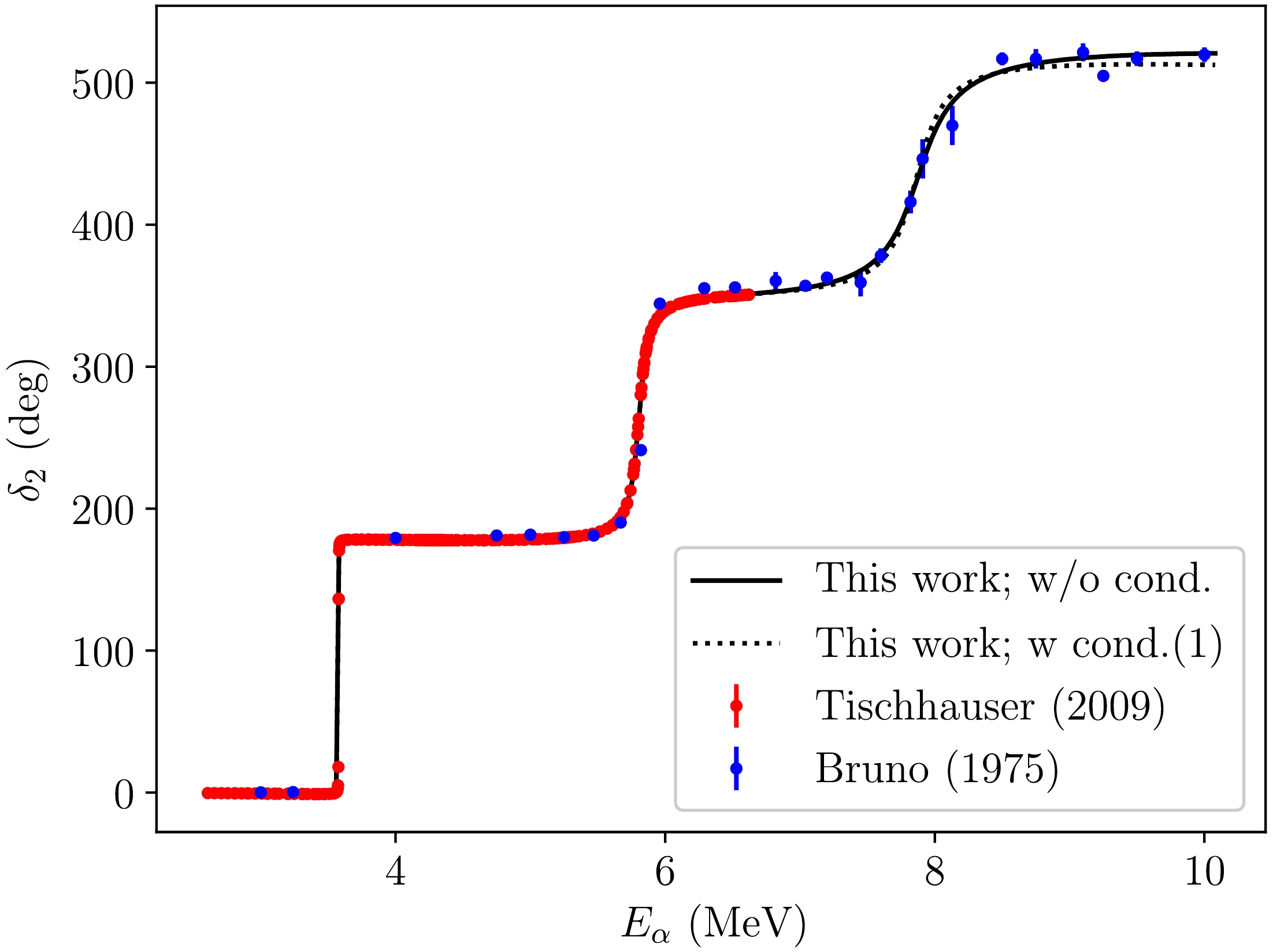
Figure 3. (color online) Phase shifts of the elastic α-12C scattering for
$ l=2 $ plotted as functions of the α energy$ E_\alpha $ in the laboratory frame. A solid line is plotted by using the values of the parameters in the third column in Table 1 and a dotted line by using those in the fourth column in the same table. The experimental data reported by Tischhauser et al. (2009) [25] and Bruno et al. (1975) [30] are displayed in the figure as well.In Fig. 4, the same lines with the bands and the data shown in Fig. 3 are displayed in the energy region for the resonant
$ 2_4^+ $ state of 16O. A dashed-dotted line using the parameters obtained in the previous work (those in the second column in Table 1) is also plotted in the figure. The bands represent the uncertainty of the phase shifts, which are calculated as the band of 16% to 84% distribution of a phase shift calculated from the samples of the parameters in the MCMC analysis. One can see that the bands fitted to the data in this work become better than that in the previous work. The two bands in this work are distinguishable, but the data have a significant size of the error bars; it may not be easy to determine which line is better than the other. As discussed above, this difference can also be seen in the different values of the parameters of the$ 2_4^+ $ state of 16O in the third and fourth columns of Table 1.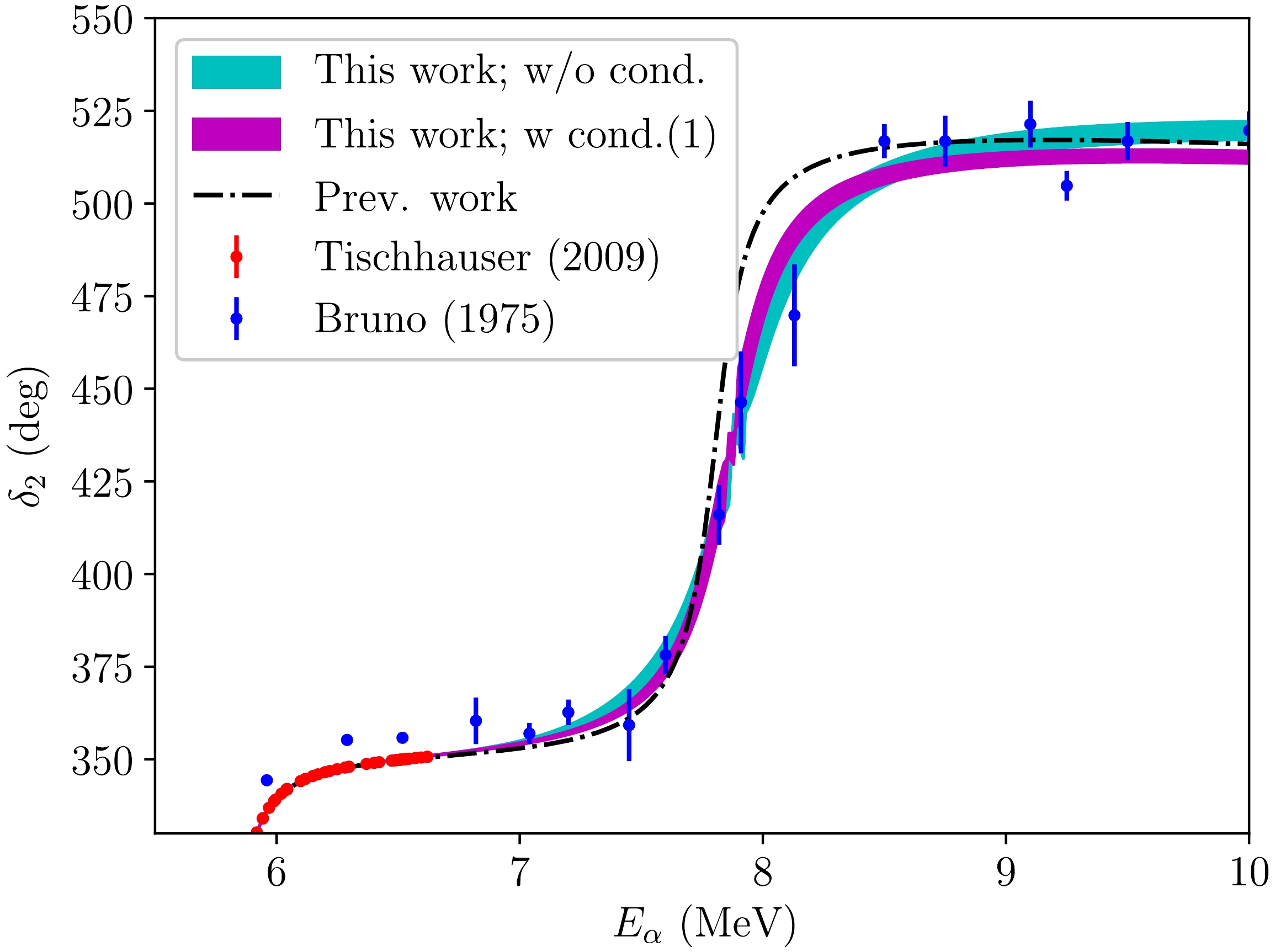
Figure 4. (color online) The same phase shifts with the bands displayed in Fig. 3 in the energy region of the resonant
$ 2_4^+ $ state plotted as functions of the α energy$ E_\alpha $ . The bands, the 16% to 84% distribution of a phase shift, are calculated from the samples of the parameters in the MCMC analysis. A dashed-dotted line is also plotted using the parameters obtained in the previous work (those in the second column in Table 1). See the caption in Fig. 3 as well.In Table 2, we summarize the values of resonant energy and width of the
$ 2_4^+ $ state of 16O,$ E_{R(24)} $ and$ \Gamma_{R(24)} $ , in the literature and our results presented in Table 1. We have larger values of the resonant energy,$ E_{R(24)} $ , by two sigma deviation from the value of Bruno et al. (1975) [30]. One can see that the values of$ \Gamma_{R(24)} $ in the literature are still scattered and the uncertainties of those values are significant; those values are in good agreement within the error bars, except for that of the compilation edited by Tilley, Weller, and Cheves (1993) [5],$ \Gamma_{R(24)}=150(10) $ keV, which is significantly smaller than the others. To improve the situation, it may be helpful to have a more precise data set of the phase shift in the energy region for the resonant$ 2_4^+ $ state of 16O. We note that because two channels, α-12C*($ 2_1^+ $ ) and p-15N states, open in this energy region, the inelastic channels of the scattering start contributing. Thus, it is necessary to improve the treatment in the theory as well. -
We are now in the position to study the effect of the conditions applied to the effective range parameters on the inverse of the propagator,
$ D_2(p) $ , and the calculation of the$ S_{E2} $ factor of the E2 transition of 12C(α,γ)16O. In Fig. 5, we plot the real part of$ D_2(E) $ [$ =D_2(p) $ ] as a function of the energy E of the α-12C system in the center-of-mass frame at the low-energy region. A solid line is calculated by using the values of$ r_2 $ ,$ P_2 $ ,$ Q_2 $ in the third column of Table 1 and a dotted line by using those in the fourth column of the same table. The experimental data of the phase shift reported by Tischhauser et al. (2009) [25] are converted to$ ReD_2(E) $ using a relation,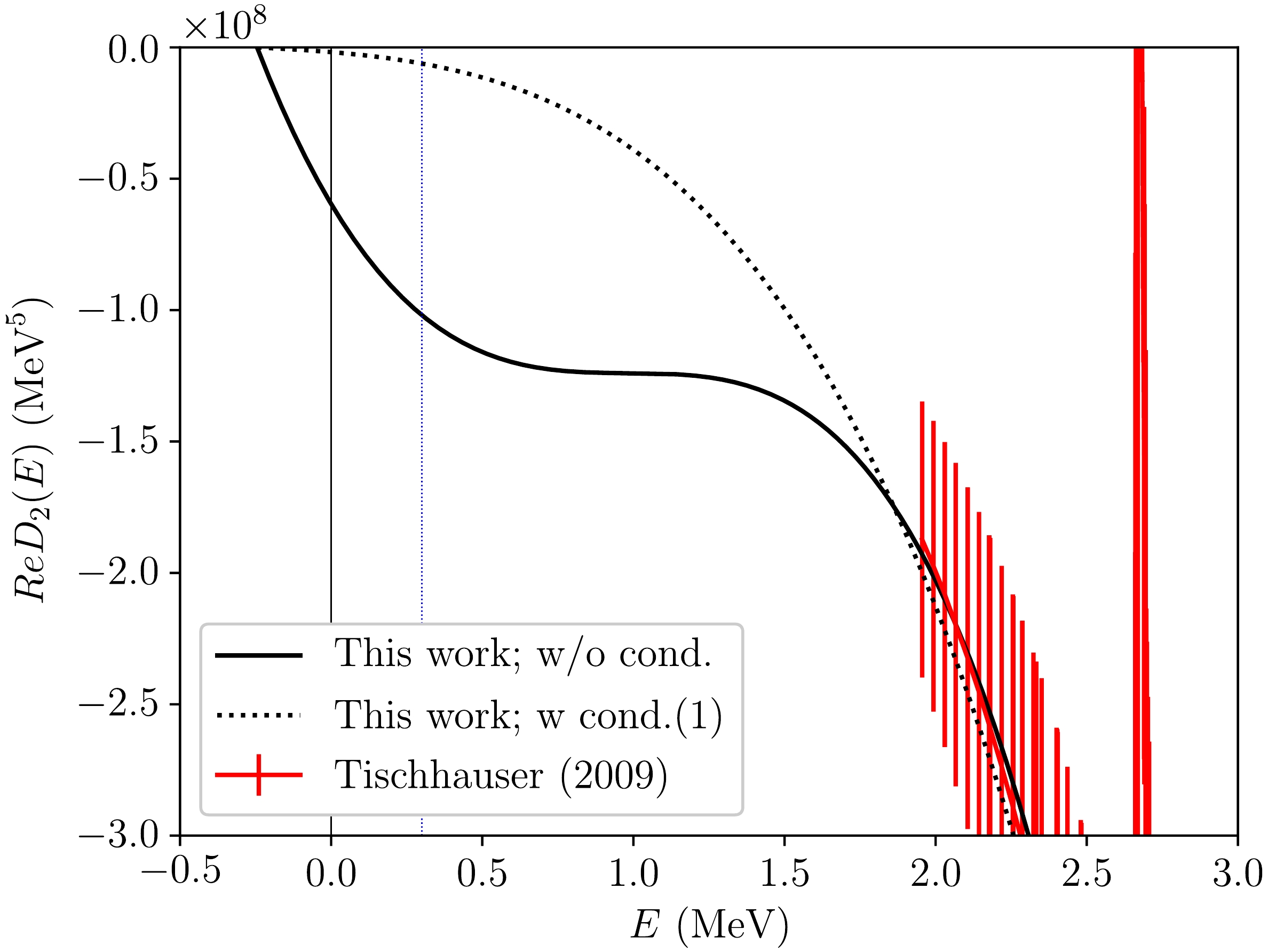
Figure 5. (color online) Real part of the inverse of the propagator,
$ ReD_2(E) $ [$ =ReD_2(p) $ ], plotted as a function of the energy E of the α-12C system in the center-of-mass frame. A solid line is plotted using the values of the effective range parameters,$ r_2 $ ,$ P_2 $ ,$ Q_2 $ , in the third column in Table 1 and a dotted line by those in the fourth column in the same table. The phase shift data reported by Tischhauser et al. (2009) [25] are converted and displayed in the figure as well. A vertical blue line is drawn at$ E_G = 0.3 $ MeV.$ \begin{aligned} ReD_2(p) = p W_2(p)C_\eta^2\cot \delta_2\,, \end{aligned} $

(30) and plotted in the figure as well. One can see that the paths of the two lines are quite different because of the conditions applied (or not applied) to the effective range parameters. The solid line has a plateau in the low energy region,
$ 0<E<1.95 $ MeV, and the dotted line is smoothly decreasing, while both lines reproduce the experimental data equally well. In addition, at the top of the figure, both lines start at the same point, i.e., at the binding energy of the$ 2_1^+ $ state of 16O,$ E=-B_2 $ , where$ D_2(-B_2)=0 $ . One may notice that the gradients of the lines at this point are also quite different; they are related to the values of the ANC of the$ 2_1^+ $ state of 16O,$ |C_b|_2 $ , in Eq. (14). Because the square of the root of the gradient appears in the denominator of the formula of$ |C_b|_2 $ , a large negative angle associated with the horizontal line at this point leads to a small value of the ANC, and a small negative angle leads to a large value of the ANC. Thus, we obtained quite different values, the small and large values of the ANC in Table 1. The two lines go through the different paths between the point at$ E=-B_2 $ and the datum of phase shift whose lowest energy is$ E=\dfrac34 E_\alpha = 1.95 $ MeV. Because the inverse of the propagator$ D_2(p) $ appears in the denominator of the E2 transition amplitudes of 12C(α,γ)16O, the energy dependence of$ D_2(E) $ [$ =D_2(p) $ ] in the low energy region is crucial when extrapolating the$ S_{E2} $ factor to$ E_G=0.3 $ MeV.By employing the two sets of fitted values of the effective range parameters in the third and fifth columns in Table 1, we fit additional parameters in the E2 transition amplitudes of 12C(α,γ)16O to the experimental data of the
$ S_{E2} $ factor of 12C(α,γ)16O. The expression of the E2 transition amplitudes and its brief derivation are presented in Appendix B; we have two additional parameters,$ h_R^{(2)} $ and$ y^{(0)} $ , in the amplitudes. The experimental data of the$ S_{E2} $ factor below the resonant energy of$ 2_2^+ $ of 16O, up to$ E=2.5 $ MeV, reported by Ouellet et al. (1996) [37], Roters et al. (1999) [38], Kunz et al. (2001) [39], Fey (2004) [40], Makii et al. (2009) [41], and Plag et al. (2012) [42], are employed for fit.In Table 3, fitted values of the parameters,
$ h_R^{(2)} $ and$ y^{(0)} $ , are presented with the$ \chi^2/N $ values. When fitting the parameters, the values of the effective range parameters,$ r_2 $ ,$ P_2 $ ,$ Q_2 $ , displayed in the third and fifth columns in Table 1 are used. Values of the$ S_{E2} $ factor at$ E_G=0.3 $ MeV are calculated by using the fitted values of the parameters,$ h_R^{(2)} $ and$ y^{(0)} $ , and displayed in the table as well. One can see in the table, the fitted values of the parameters,$ h_R^{(2)} $ and$ y^{(0)} $ , are still scattered for the two cases. The$ \chi^2/N $ values in the last two columns are$ \chi^2/N= 1.55 $ and 1.18, and the deduced values of$ S_{E2} $ at$ E_G $ show a difference of a factor of ten. We have$ S_{E2} = 4.1 \pm 0.2 $ and$ 40^{+14}_{-12} $ keVb, respectively. Those two values are still within the range of previously reported values of the$ S_{E2} $ factor summarized in Table IV in Ref. [9].$ |C_b|_2 $ (fm−1/2)

This work (w/o cond.) $ 3.2\times 10^4 $ 

This work (w cond.(2)) $ 10\times 10^4 $ 

$ h_R^{(2)}\times 10^{-11} $ (MeV4)

$ 50.6\pm 0.4 $ 

$ 45.53^{+0.04}_{-0.03} $ 

$ y^{(0)} $ (MeV−1/2)

$ 1.99\pm 0.01 \times 10^{-3} $ 

$5.9 \pm 0.1\times 10^{-2} $ 

$ \chi^2/N $ (

$ N=51 $ )

1.55 1.18 $ S_{E2} $ (keVb) at

$ E_G $ 

$ 4.1\pm 0.2 $ 

$ 40^{+14}_{-12} $ 

Table 3. Values of
$ h_R^{(2)} $ and$ y^{(0)} $ fitted to the experimental data of the$ S_{E2} $ factor by using the two sets of values of the effective range parameters,$ r_2 $ ,$ P_2 $ ,$ Q_2 $ . For the values in the second column, the values of$ r_2 $ ,$ P_2 $ ,$ Q_2 $ presented in the third column of Table 1 are used, and for those in the third column, the values of$ r_2 $ ,$ P_2 $ ,$ Q_2 $ presented in the fifth column of Table 1 are used.$ \chi^2/N $ values for the fit are displayed in the table as well.$ S_{E2} $ at$ E_G=0.3 $ MeV is calculated by using the fitted parameters.In Fig. 6, two bands of the
$ S_{E2} $ factor of 12C(α,γ)16O are plotted as functions of the energy E of the initial α-12C state in the center-of-mass frame. The experimental data of the$ S_{E2} $ factor are included in the figure as well. A band of cyan of the$ S_{E2} $ factor, which exhibits a minimum point and a maximum point, is calculated by using the fitted values of the parameters to which the conditions to the effective range parameters are not applied, and a band of magenta of the$ S_{E2} $ factor, which is simply decreasing, is by using those to which the conditions are applied and one of the three effective range parameters is constrained by the value of the ANC,$ |C_b|_2 = 10\times 10^4 $ fm−1/2, with Eq. (29). One can see that the energy dependence of the$ S_{E2} $ factor stems mainly from that of$ D_2(E) $ , which appear in the denominator of the E2 transition amplitudes of 12C(α,γ)16O, displayed in Fig. 5. The$ \chi^2/N $ values of the bands are 1.55 and 1.18, respectively, and it indicates that the band of magenta is better to fit the data than that of cyan. -
In this work, we first studied the elastic α-12C scattering for
$ l=2 $ introducing the conditions applied to the effective range parameters,$ r_2 $ ,$ P_2 $ ,$ Q_2 $ , when fixing them to the phase shift data. We employed the two data sets of the elastic scattering; one is precise phase shift data up to the p-15N breakup energy,$ E_\alpha=6.62 $ MeV, reported by Tischhauser et al. (2009) [25], and the other is the data set up to$ E_\alpha=10 $ MeV where the resonant$ 2_4^+ $ state of 16O is covered by the data, reported by Bruno et al. (1975) [30]. We fit the parameters of the S matrix of the elastic α-12C scattering for$ l=2 $ to the phase shift data for the three cases; one is without applying the conditions, and the other two are with the conditions applied to the effective range parameters in the low-energy region where no experimental data are reported. In one of the two with the conditions applied, the value of the ANC of the$ 2_1^+ $ state of 16O,$ |C_b|_2 = 10\times 10^4 $ fm−1/2, is used to fix one of the effective range parameters,$ r_2 $ . We found the larger values of the width of the$ 2_4^+ $ state of 16O,$ \Gamma_{R(24)}= 235(20) $ and$ 300^{+60}_{-40} $ keV, than that listed in the compilation,$ \Gamma_{R(24)}=150(10) $ keV [5], and the large and small values of ANC of the$ 2_1^+ $ state of 16O,$ |C_b|_2 = 23.3\times 10^4 $ and$ 3.24\times 10^4 $ fm−1/2, for the two of the three cases, respectively, while all of the three sets of the fitted parameters equally reproduce the phase shift data well. The fitted values of the effective range parameters for two sets of the three cases were applied to the study of the$ S_{E2} $ factor of 12C(α,γ)16O. First, we study the energy dependence of the inverse of 16O propagator for$ l=2 $ in the low energy region where the$ S_{E2} $ factor is extrapolated to$ E_G $ . Then, we fit the additional two parameters,$ h_R^{(2)} $ and$ y^{(0)} $ , of the E2 transition amplitude of 12C(α,γ)16O to the experimental data of the$ S_{E2} $ factor with the$ \chi^2/N $ values,$ \chi^2/N=1.18 $ and 1.55, and extrapolate the$ S_{E2} $ factor to$ E_G $ , where, as mentioned, we have fixed one of the effective range parameters for the case of the large ANC by adopting the ANC of the$ 2_1^+ $ state of 16O deduced from the α-transfer reactions,$ |C_b|_2=10\times 10^4 $ fm−1/2. We obtain$ S_{E2}= 40^{+14}_{-12} $ and$ 4.1 \pm 0.2 $ keVb at$ E_G=0.3 $ MeV, respectively; we find that both values are within the range of previously reported values of$ S_{E2} $ at$ E_G $ in the literature.There is no restriction on whether one should apply the conditions to the effective range parameters or not when fitting to the phase shift data because the phase shift data are equally well-fitted for all cases. In other words, the phase shift data for
$ l=2 $ cannot determine which line drawn in Fig. 5 is better than the other, while it is crucial to extrapolate the$ S_{E2} $ factor to$ E_G $ . One may argue the need to introduce the conditions employing an argument of the simplicity of natural laws, as once discussed by Poincaré; he wrote “natural laws must be simple” [43]. For the present case, one may regard that the dotted line (simply decreasing) is simpler than the solid line (having a plateau) in Fig. 5; the appearance of such a bump of the$ S_{E2} $ factor in Fig. 6 might indicate interference with an unknown bound or resonant state at the low energies. While such an assumption should be tested by experiment or other possible methods.A quantity that could test a verification of the conditions may be the width of the resonant
$ 2_4^+ $ state of 16O. The reported values displayed in Table 2 are still scattered, but the value,$ \Gamma_{R(24)}= 349(3) $ keV, recently reported by deBoer et al. (2012) could support the result of$ \Gamma_{R(24)} = 300^{+60}_{-40} $ keV, which was obtained without applying the conditions. Meanwhile, as discussed above, we need to improve the treatment in theory because the new channels start opening in this energy region.The experimental data of the
$ S_{E2} $ factor of 12C(α,γ)16O may provide another quantity to test the verification of the conditions because the data cover the lower energy region,$ E=0.9 $ –$ 1.95 $ MeV ($ E_\alpha = \frac43 E=1.2 $ –$ 2.6 $ MeV) than those of the elastic α-12C scattering though the data of the$ S_{E2} $ factor have large error bars, especially in the lower energy region,$ E=0.9 $ – 1.2 MeV. After fitting the two parameters,$ h_R^{(2)} $ and$ y^{(0)} $ , of the E2 transition amplitudes of 12C(α,γ)16O, we have the$ \chi^2/N $ values for the two of the three cases as$ \chi^2/N=1.18 $ and 1.55; this may support applying the conditions in the low-energy region while the data of the$ S_{E2} $ factor still have the large uncertainties. More accurate measurements of the$ S_{E2} $ factor in the energy range,$ E=0.9 $ – 1.5 MeV, would be helpful to obtain a clear conclusion.The values of the ANC of the
$ 2_1^+ $ state of 16O we obtained in this work are still quite different for the two cases,$ |C_b|_2 = 3.24\times 10^4 $ and$ 23.3\times 10^4 $ fm−1/2. As mentioned, the values of$ |C_b|_2 $ are deduced from the α transfer reactions, such as 12C(6Li,d)16O [44]; the value of$ |C_b|_2 $ is recently updated by Hebborn et al. as$ |C_b|_2 = 10.7(3)\times 10^4 $ fm−1/2 [45] by using the ANC of the ground state of 6Li as d-α system deduced from their ab initio calculation [46]. As discussed above, we have employed a value of the ANC,$ |C_b|_2=10\times 10^4 $ fm−1/2, adopted from the α-transfer reactions to constrain the values of the effective range parameters by Eq. (29) when fitting them to the phase shift data applying the conditions, and we have$ S_{E2}=40^{+14}_{-12} $ keV b with$ \chi^2/N=1.18 $ . The$ \chi^2 $ value is small but the error of the$ S_{E2} $ factor is significantly large, about 35% error. This may also stem from the large errors of the data of the$ S_{E2} $ factor. Thus, it would be important to reduce the error bar of the$ S_{E2} $ factor estimated in the theory by using the other available experimental data. The study in this direction is now under investigation. -
The author would like to thank D. Phillips, T. Kajino, R. deBoer, and C. H. Hyun for discussions.
-
In this appendix, we discuss the relations related to the function
$ H_2(p) $ in Eq. (7) in the low energy limit,$ p\to 0 $ . Using two formulas of the digamma function$ \psi(z) $ ; one is Eq. 6.3.18 in Ref. [47],$ \begin{aligned}[b] \psi(z) &\sim \ln z - \frac{1}{2z} - \sum_{n=1}^\infty \frac{B_{2n}}{2nz^{2n}}\, {} \\ &= \ln z - \frac{1}{2z} - \frac{1}{12 z^2} - \frac{1}{120 z^4} - \frac{1}{252 z^6} - \cdots\,, \end{aligned} $

(A1) for
$ |z|\to \infty $ and$ |arg z| <\pi $ , where$ B_{2n} $ are the Bernoulli numbers,$ \begin{aligned} B_2 = \frac16\,, \ \ B_4 = - \frac{1}{30}\,, \ \ B_6 = \frac{1}{42}\,, \ \ B_8 = - \frac{1}{30}\,, \ \ B_{10} = \frac{5}{66}\,, \ \ \cdots\,, \end{aligned} $

(A2) and the other is Eq. 5.4.16 in Ref. [48],
$ \begin{aligned} Im \psi(iy) = \frac{1}{2y} + \frac{\pi}{2}\coth(\pi y)\,, \end{aligned} $

(A3) one can rewrite the imaginary part and real part of the function
$ H(\eta) $ in Eq. (7) as$ \begin{aligned} Im H(\eta) &= Im \psi(i\eta) - \frac{1}{2\eta} -\pi = \frac{1}{2\eta} \frac{2\pi \eta}{e^{2\pi\eta}-1} = \frac{1}{2\eta}C_\eta^2\,, \end{aligned} $

(A4) $ \begin{aligned}[b] Re H(\eta) =\;& Re \psi(i\eta) - \ln\eta = - \sum_{n=1}^\infty \frac{B_{2n}}{2n(i\eta)^{2n}} {} = \frac{1}{12\eta^2} \\ &+ \frac{1}{120\eta^4} + \frac{1}{252\eta^6} + \frac{1}{240\eta^8} + \frac{1}{132\eta^{10}} + \cdots\,. \end{aligned} $

(A5) Now one may obtain the expression of
$ 2\kappa Re H_2(p) $ in Eq. (8).The expressions of
$ ReD_2(p) $ in Eq. (19) is calculated as the following. First one may expand$ H(\eta) $ function using the equation above, and one has an expression of$ ReD_2(p) $ as$ \begin{aligned}[b] ReD_2(p) =\;& a(\gamma_2^2 + p^2) + b (\gamma_2^4 - p^4) + c (\gamma_2^6 + p^6) + d (\gamma_2^8 - p^8)\\& + e (\gamma_2^{10} + p^{10}) + \cdots\,, \end{aligned} $

(A6) where a, b, c, d, e are coefficients. Explicitly, we have
$ \begin{aligned} ReD_2(p) =\;& \left(\frac12 r_2 - \frac{1}{24}\kappa^3\right)(\gamma_2^2+p^2) +\left( \frac14P_2 + \frac{17}{80}\kappa \right)(\gamma_2^4 - p^4) {} \\ & + \left( Q_2 - \frac{757}{4032\kappa} \right)(\gamma_2^6+p^6) + \frac{289}{10080\kappa^3}(\gamma_2^8 -p^8)\\& - \frac{491}{22176\kappa^5}(\gamma_2^{10} + p^{10}) {} +\cdots\,. \end{aligned} $

(A7) Then, one may use the relations,
$ \begin{aligned} \gamma_2^4 - p^4 = - (\gamma_2^2 + p^2)^2 + 2\gamma_2^2 (\gamma_2^2 + p^2)\,, \end{aligned} $

(A8) $ \begin{aligned} \gamma_2^6 + p^6 = (\gamma_2^2 + p^2)^3 -3\gamma_2^2 (\gamma_2^2+p^2)^2 + 3\gamma_2^4(\gamma_2^2+p^2)\,, \end{aligned} $

(A9) $ \begin{aligned}[b] \gamma_2^8 -p^8 =\;& -(\gamma_2^2+p^2)^4 + 4 \gamma_2^2 (\gamma_2^2 + p^2)^3 \\&- 6 \gamma_2^4 (\gamma_2^2+p^2)^2 + 4 \gamma_2^6 (\gamma_2^2 + p^2) \,, \end{aligned} $

(A10) $ \begin{aligned}[b] \gamma_2^{10} + p^{10} =\;& (\gamma_2^2 + p^2)^5 -5\gamma_2^2(\gamma_2^2 + p^2)^4 +10\gamma_2^4(\gamma_2^2+p^2)^3 \\&-10\gamma_2^6(\gamma_2^2+p^2)^2 {} +5\gamma_2^8(\gamma_2^2+p^2)\,, \end{aligned} $

(A11) and has the expression
$ \begin{aligned} ReD_2(p)\simeq \sum_{n=1}^5 C_n (\gamma_2^2 + p^2)^n\,, \end{aligned} $

(A12) with
$ \begin{aligned} C_1 = a + 2\gamma_2^2 b + 3\gamma_2^4 c + 4 \gamma_2^6 d + 5 \gamma_2^8 e\,, \end{aligned} $

(A13) $ \begin{aligned} C_2 =-b -3\gamma_2^2 c - 6 \gamma_2^4d -10\gamma_2^6 e\,, \end{aligned} $

(A14) $ \begin{aligned} C_3 = c + 4\gamma_2^2 d + 10\gamma_2^4 e\,, \end{aligned} $

(A15) $ \begin{aligned} C_4 = -d - 5\gamma_2^2 e\,, \end{aligned} $

(A16) $ \begin{aligned} C_5 = e\,. \end{aligned} $

(A17) Then, one may obtain the expressions of the coefficients,
$ C_i $ with$ i=1,2,3,4,5 $ in Eqs. (20,21,22,23,24). -
In this appendix, we present the expression of the E2 transition amplitudes of 12C(α,γ)16O and briefly discuss its derivation. In Fig. B1, the diagrams of the reaction are displayed. The vertex functions and propagators are derived from the effective Lagrangian and we have the E2 transition amplitude of 12C(α,γ)16O as
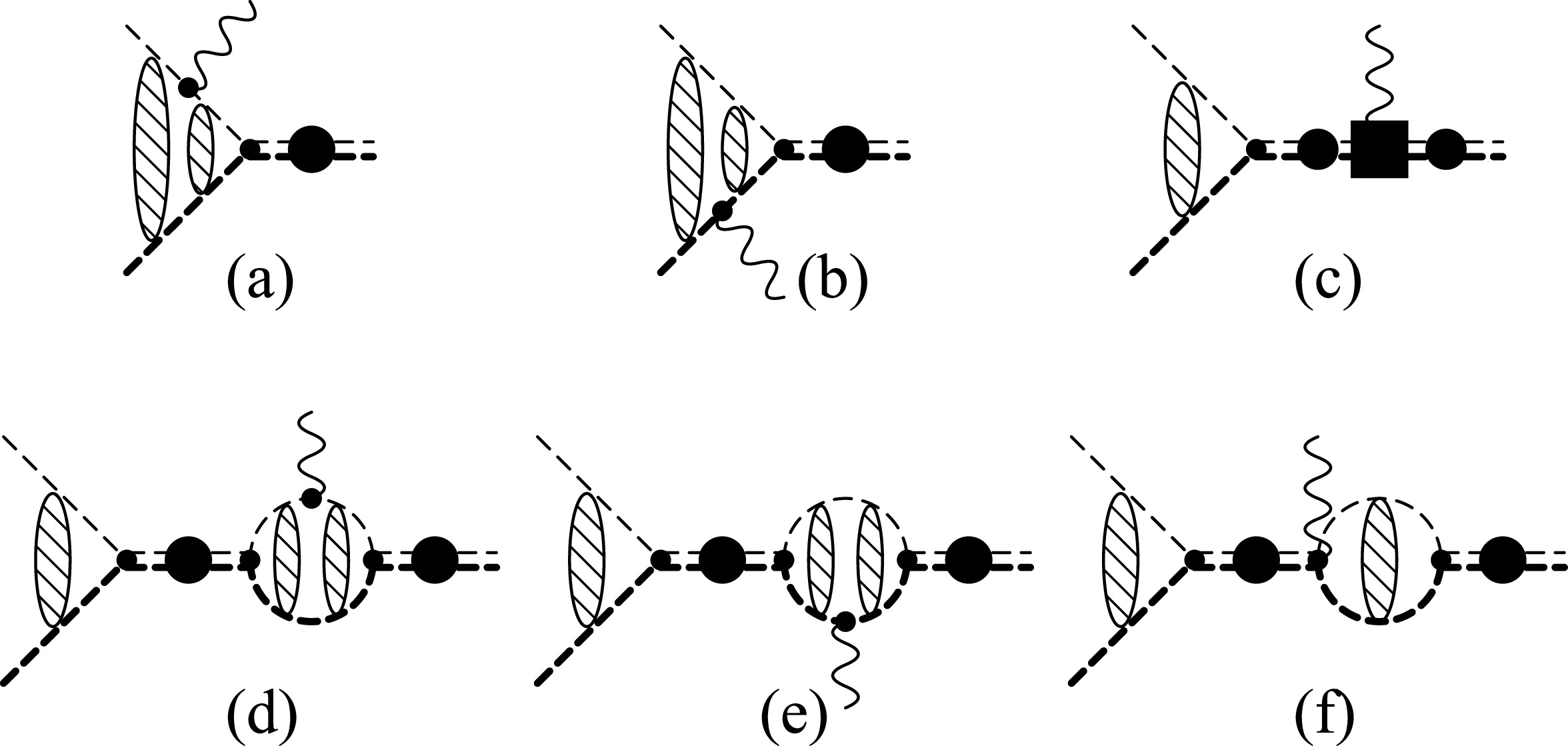
Figure B1. Diagrams of amplitudes for radiative α capture on 12C. A wavy line and a thin (thick) dashed line denote the outgoing photon and α (12C) state, respectively. Double thin-and-thick lines with a filled circle denote the dressed 16O propagators for
$ 2_1^+ $ state in the intermediate state and for$ 0_1^+ $ state in the final state. See the caption in Fig. 1 as well. A$ O\gamma O^* $ vertex in the diagram (c) is a counter term proportional to$ h_R^{(2)} $ to renormalize the infinities from loop diagrams in (d), (e), (f).$ \begin{aligned} A^{(l=2)} = \vec{\epsilon}_{(\gamma)}^* \cdot \hat{p} \hat{k}'\cdot\hat{p} X^{(l=2)}\,, \end{aligned} $

(B1) where
$ \vec{\epsilon}^*_{(\gamma)} $ is the polarization vector of the outgoing photon,$ \hat{k}' $ is the unit vector of photon three-momentum, and$ \hat{p} $ is the unit vector of relative momentum of the initial α-12C system. The amplitude$ X^{(l=2)} $ is decomposed as$ \begin{aligned} X^{(l=2)} = X^{(l=2)}_{(a+b)} + X^{(l=2)}_{(c)} + X^{(l=2)}_{(d+e)} + X^{(l=2)}_{(f)} \,, \end{aligned} $

(B2) where each amplitude corresponds to the diagrams depicted in Fig. B1. Thus, we have
$ \begin{aligned}[b] X_{(a+b)}^{(l=2)} = - 6y^{(0)} e^{i\sigma_2} \Gamma(1+\kappa/\gamma_0) {} \times \int_0^\infty drrW_{-\kappa/\gamma_0,\frac12}(2\gamma_0 r) \left[ \frac{Z_\alpha \mu}{m_\alpha}j_1\left( \frac{\mu}{m_\alpha} k'r \right) +\frac{Z_C \mu}{m_C}j_1\left( \frac{\mu}{m_C} k'r \right) \right] {} \times \left( \frac{\partial}{\partial r} + \frac{3}{r} \right) \frac{F_2(\eta,pr)}{pr}\,, \end{aligned} $

(B3) $ \begin{aligned} X_{(c)}^{(l=2)} = + y^{(0)} \left\{ - h_R^{(2)} + \frac{3\kappa\mu^3m_O^2}{2\pi Z_O} \left( \frac{Z_\alpha}{m_\alpha^2} + \frac{Z_C}{m_C^2} \right) \left[ \frac{4}{225} \ln\left( \frac{\mu_{DR}}{2}r_C \right) - \ln\left( \frac{\mu_{DR}}{\kappa} \right) \right] \right\} {} \times \frac{5\pi Z_O}{\mu m_O^2} \frac{e^{i\sigma_2}k'p^2\sqrt{(1+\eta^2)(4+\eta^2)}C_\eta}{ K_2(p) - 2\kappa H_2(p)}\,, \end{aligned} $

(B4) $ \begin{aligned} X_{(d+e)}^{(l=2)} =\;& + \frac{1}{5}y^{(0)} \frac{ e^{i\sigma_2}p^4\sqrt{(1+\eta^2)(4+\eta^2)}C_\eta }{ K_2(p)-2\kappa H_2(p) } \Gamma(1+\kappa/\gamma_0) \Gamma(3+i\eta) {} \times \int_{r_C}^\infty drrW_{-\kappa/\gamma_0,\frac12}(2\gamma_0 r) \Bigg[ \frac{Z_\alpha \mu}{m_\alpha}j_1\left( \frac{\mu}{m_\alpha} k'r \right)\\& +\frac{Z_C \mu}{m_C}j_1\left( \frac{\mu}{m_C} k'r \right) \Bigg] {} \times \left( \frac{\partial}{\partial r} + \frac{3}{r} \right) \frac{W_{-i\eta,\frac52}(-2ipr)}{r}\,, \end{aligned} $

(B5) $ \begin{aligned} X_{(f)}^{(l=2)} = - \frac{15}{4} y^{(0)} \mu^2\left( \frac{Z_\alpha}{m_\alpha^2} + \frac{Z_C}{m_C^2} \right) \left[-2\kappa H(\eta_{0b})\right] \frac{e^{i\sigma_2} k'p^2\sqrt{(1+\eta^2)(4+\eta^2)}C_\eta}{ K_2(p) - 2\kappa H_2(p) } \,, \end{aligned} $

(B6) where
$ m_\alpha $ ,$ m_C $ ,$ m_O $ ($ Z_\alpha $ ,$ Z_C $ ,$ Z_O $ ) are the mass of (the number of protons in) α, 12C, 16O, respectively. μ and κ are the reduced mass and the inverse of the Boer radius of α-12C system.$ k' $ and p are the magnitudes of three momentum of outgoing photon and that of relative momentum of the α-12C system in the center-of-mass frame. η is the Sommerfeld parameter$ \eta = \kappa/p $ .$ \gamma_0 $ is the binding momentum of the ground state of 16O;$ \gamma_0 = \sqrt{2\mu B_0} $ where$ B_0 $ is the binding energy of α-12C system in the ground state of 16O, and$ \eta_{0b} = \kappa/(i\gamma_0) $ .$ \Gamma(z) $ ,$ j_l(x) $ ,$ F_l(\eta,\rho) $ ,$ W_{\kappa,\mu}(z) $ are the gamma function, the spherical Bessel function, the regular Coulomb function, and the Whittaker function, respectively.$ \sigma_2 $ is the Coulomb phase shift for$ l=2 $ .The three loop diagrams of the
$ O\gamma O^* $ vertex in the figures (d), (e), (f) in Fig. B1 diverge. The log divergence appears in the r-space integral in$ r\to 0 $ limit in Eq. (52) for the diagrams (d) and (e); we introduce a cutoff$ r_C $ in the r-space integral and the infinite part is renormalized by the counter term,$ h^{(2)} $ , in Eq. (51). The divergence appearing in the diagram (f) was regulated in the momentum space integral as$ J_0^{div} $ by means of the dimensional regularization [49, 50]. Those infinities are renormalized by the renormalized coefficient,$ h_R^{(2)} $ , as$\begin{aligned}[b]& - h^{(2)} + \frac{3\mu^2 m_O^2}{2Z_O} \left( \frac{Z_\alpha}{m_\alpha^2} + \frac{Z_C}{m_C^2} \right)\\& \left[ - J_0^{div} + \frac{4\kappa\mu}{225\pi} \left( \frac{\mu_{DR}}{2} \right)^{2\epsilon} \int_0^{r_C}\frac{dr}{r^{1-2\epsilon}} \right] {} \\ =\;& - h_R^{(2)} + \frac{3\kappa\mu^3m_O^2}{2\pi Z_O} \left( \frac{Z_\alpha}{m_\alpha^2} + \frac{Z_C}{m_C^2} \right)\\& \left[ - \ln\left( \frac{\mu_{DR}}{\kappa} \right) + \frac{4}{225} \ln\left( \frac{\mu_{DR}}{2}r_C \right) + O(\epsilon) \right]\,,\end{aligned} $

(B7) with
$ \begin{aligned} J_0^{div} =\frac{\mu\kappa}{2\pi}\left[ \frac{1}{\epsilon} - 3C_E + 2 + \ln\left( \frac{\pi\mu_{DR}^2}{4\kappa^2} \right) \right]\,, \end{aligned} $

(B8) where we performed the integration in
$ d=4-2\epsilon $ dimensions, and$ \mu_{RD} $ is the scale of the dimensional regularization and$ C_E $ is the Euler's constant,$ C_E = 0.5771\cdots $ ; we choose$ \mu_{DR} = \Lambda_H = 160 $ MeV. We found that a minor cutoff$ r_C $ dependence and choose$ r_C = 0.01 $ fm. The E2 transition amplitudes up to this order have two additional parameters,$ h_R^{(2)} $ and$ y^{(0)} $ , along with the effective range parameters,$ r_2 $ ,$ P_2 $ ,$ Q_2 $ in the function of$ K_2(p) $ .The total cross-section is
$ \begin{aligned} \sigma_{E2} = \frac43\frac{\alpha_E \mu E_\gamma'}{p (1+E_\gamma'/m_O)} \frac15|X^{(l=2)}|^2 \,, \end{aligned} $

(B9) where
$ E_\gamma' (=k') $ is the energy of outgoing photon,$ \begin{aligned} E_\gamma' \simeq B_0 + E - \frac{1}{2m_O}(B_0+E)^2\,, \end{aligned} $

(B10) and the
$ S_{E2} $ factor is defined as$ \begin{aligned} S_{E2}(E) &= \sigma_{E2}(E)Ee^{2\pi\eta}\,. \end{aligned} $

(B11)
Fixing effective range parameters in elastic α-12C scattering: an impact on resonant 24+ state of 16O and SE2 factor of 12C(α,γ)16O
- Received Date: 2025-02-21
- Available Online: 2025-10-01
Abstract: Elastic α-12C scattering for





 Abstract
Abstract HTML
HTML Reference
Reference Related
Related PDF
PDF







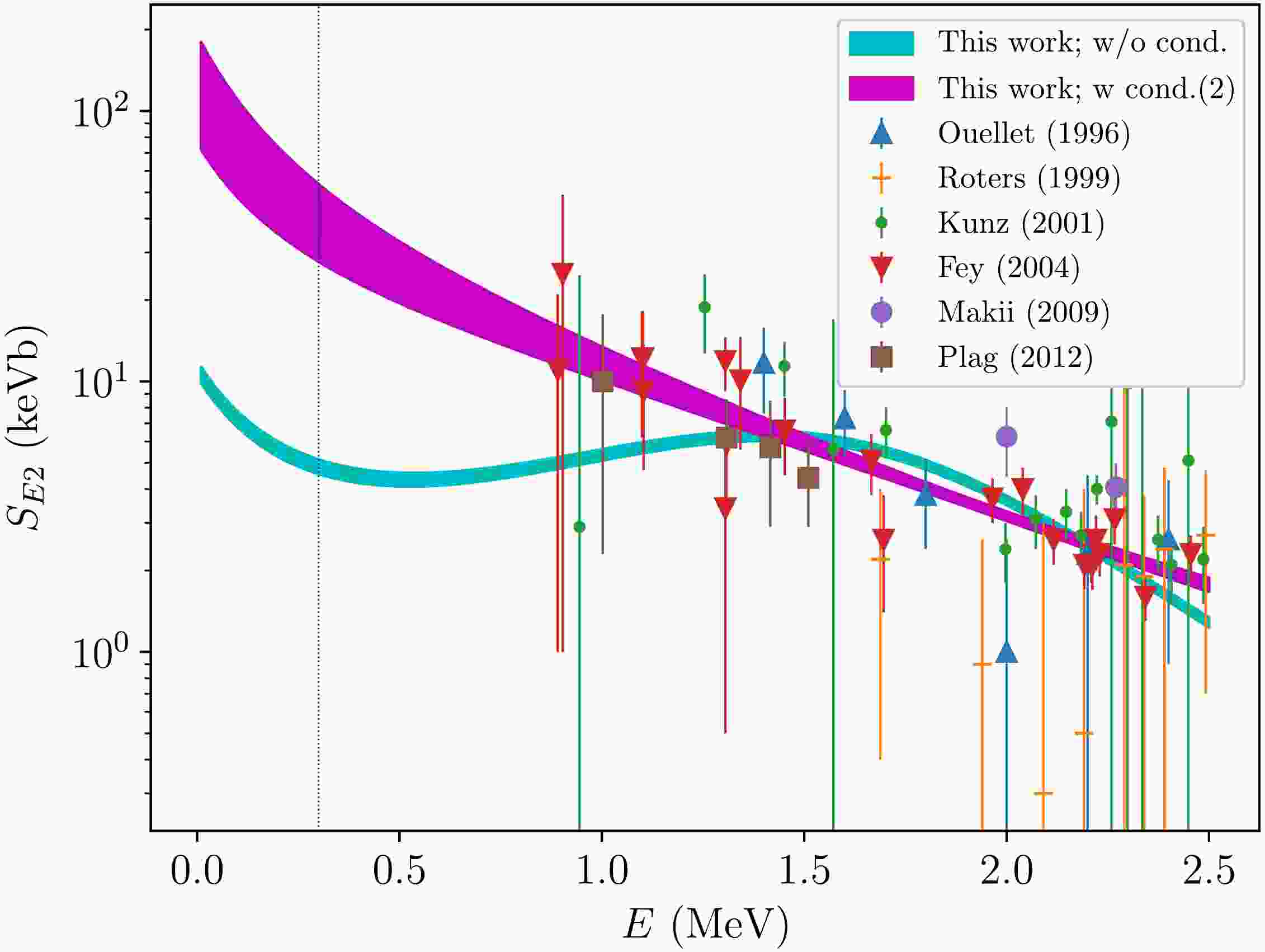













 DownLoad:
DownLoad:

